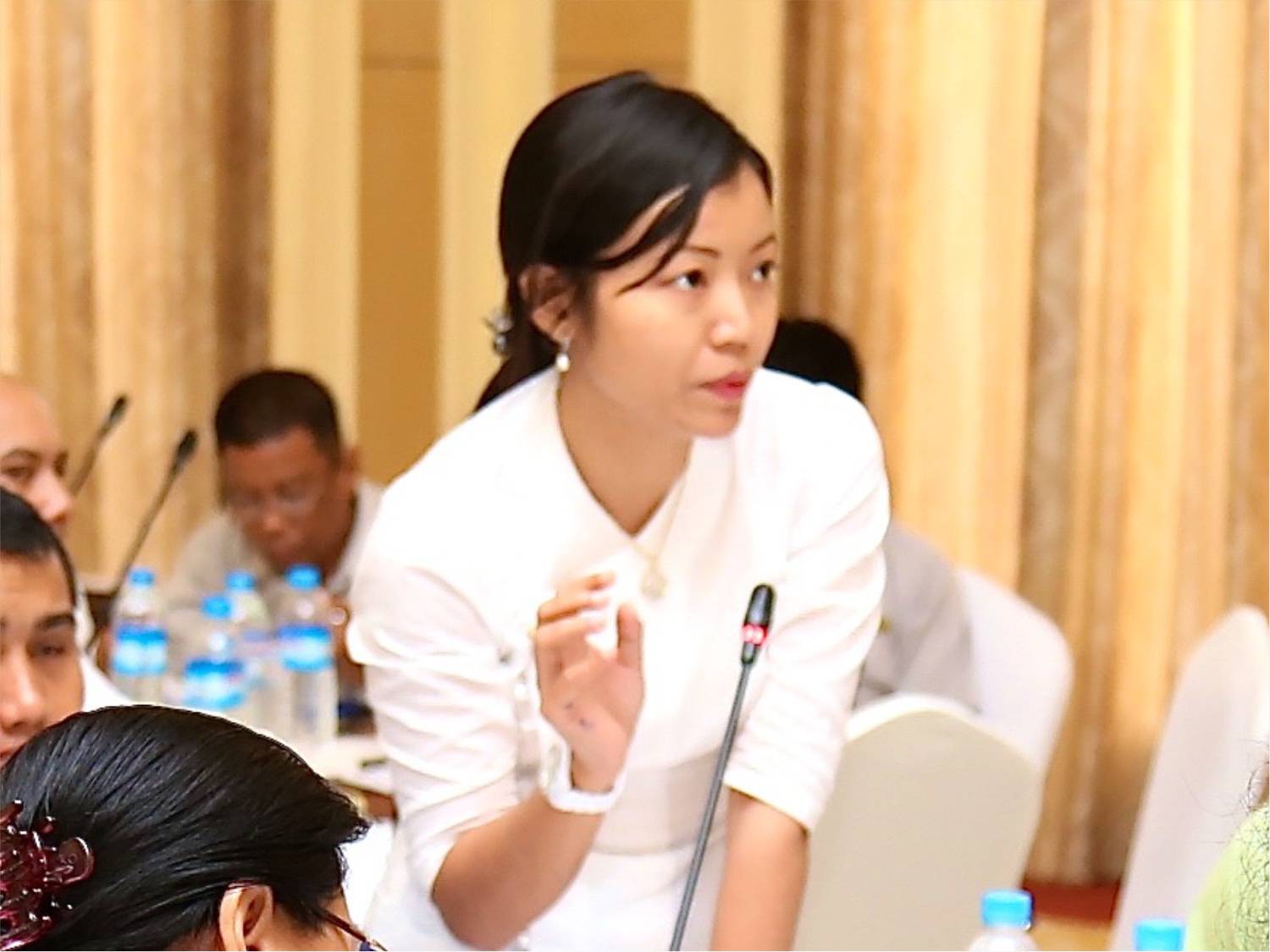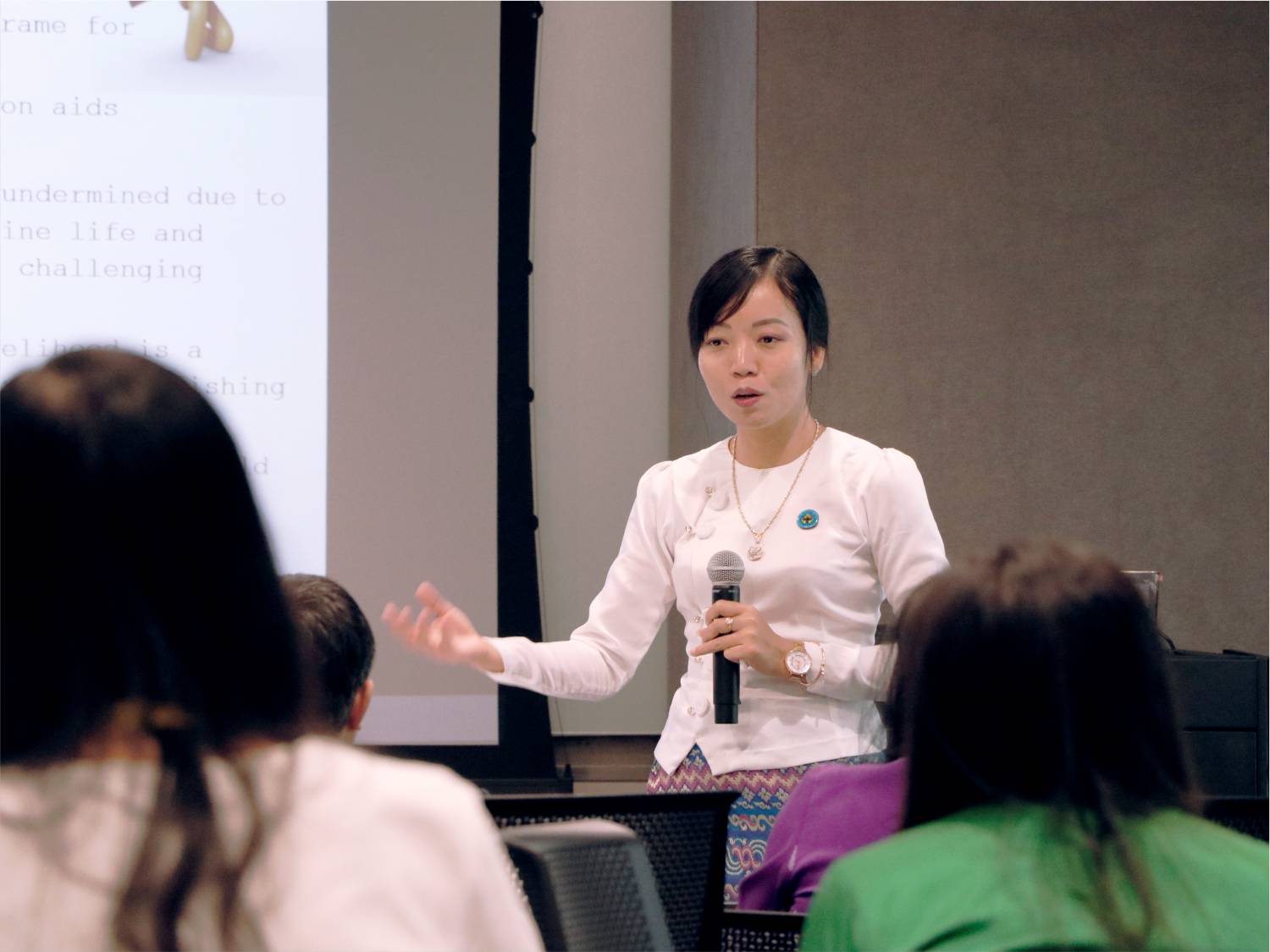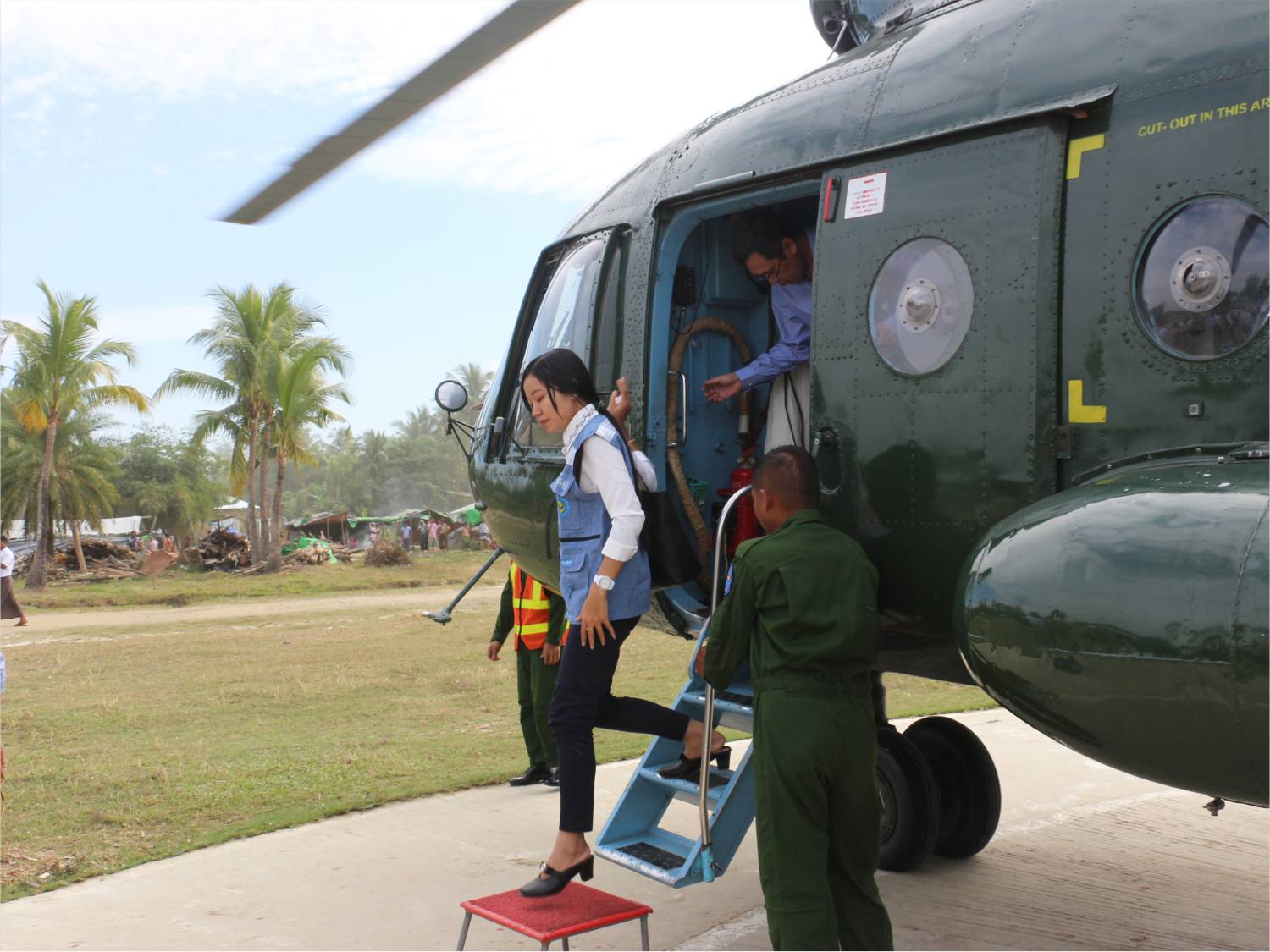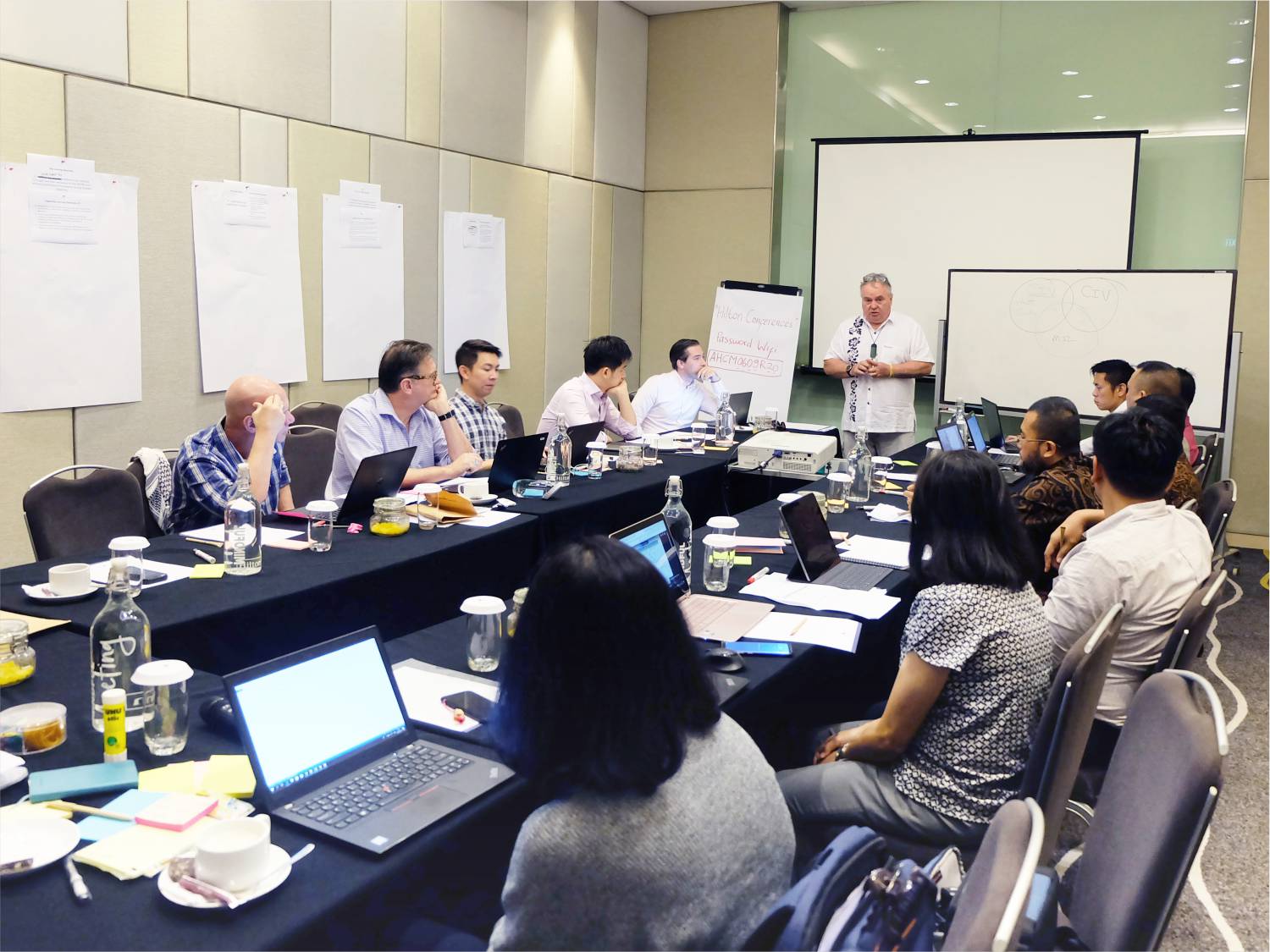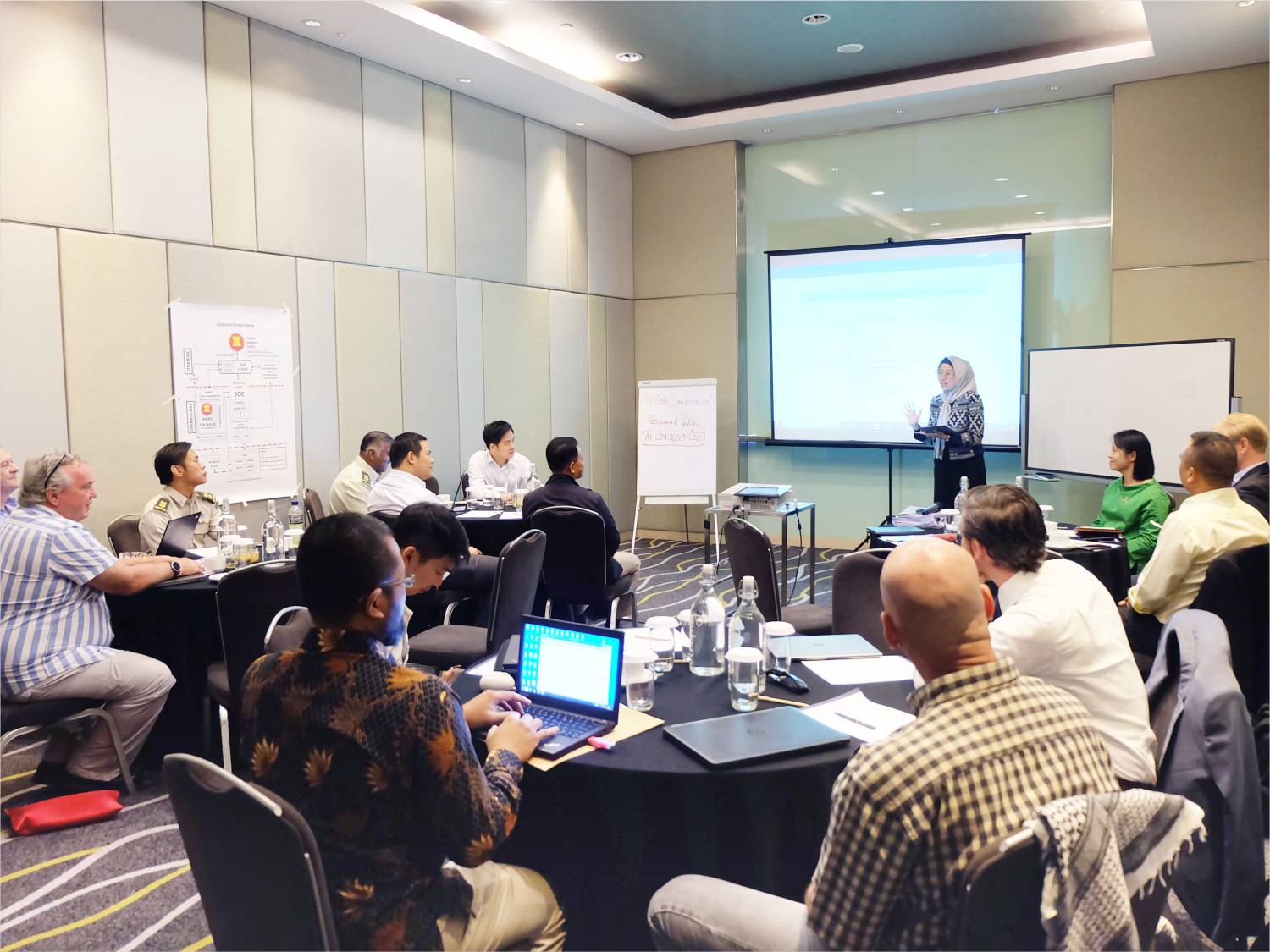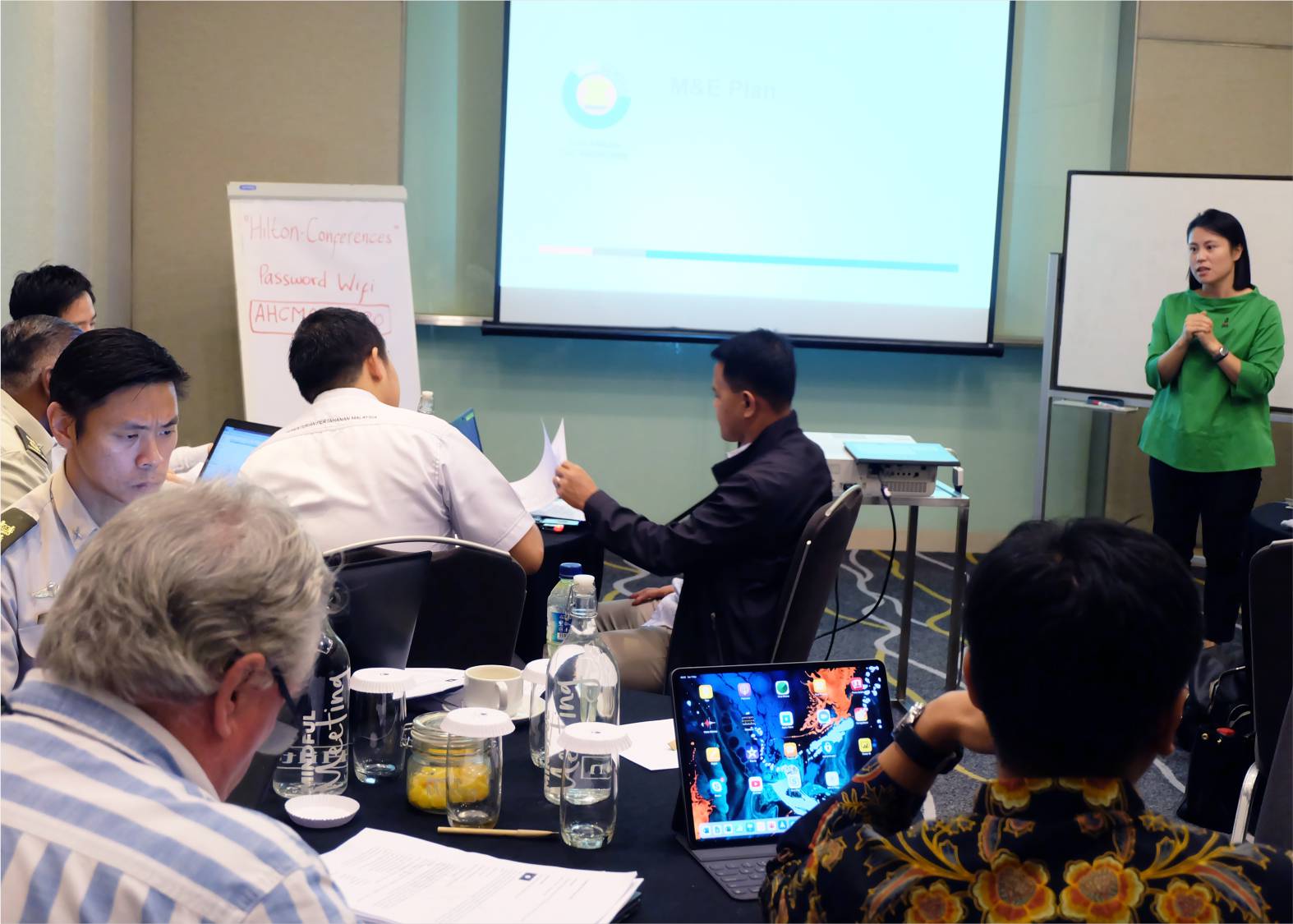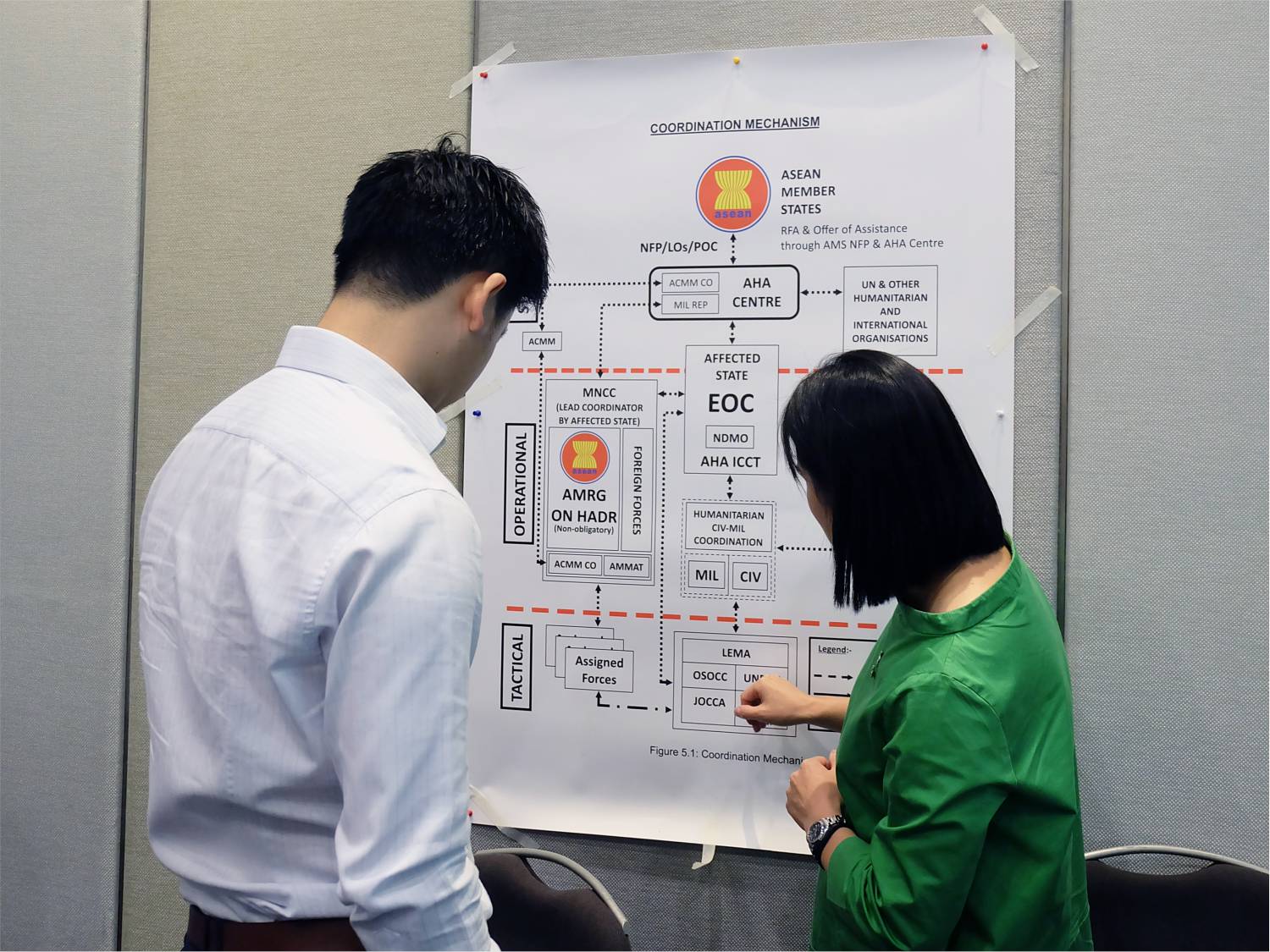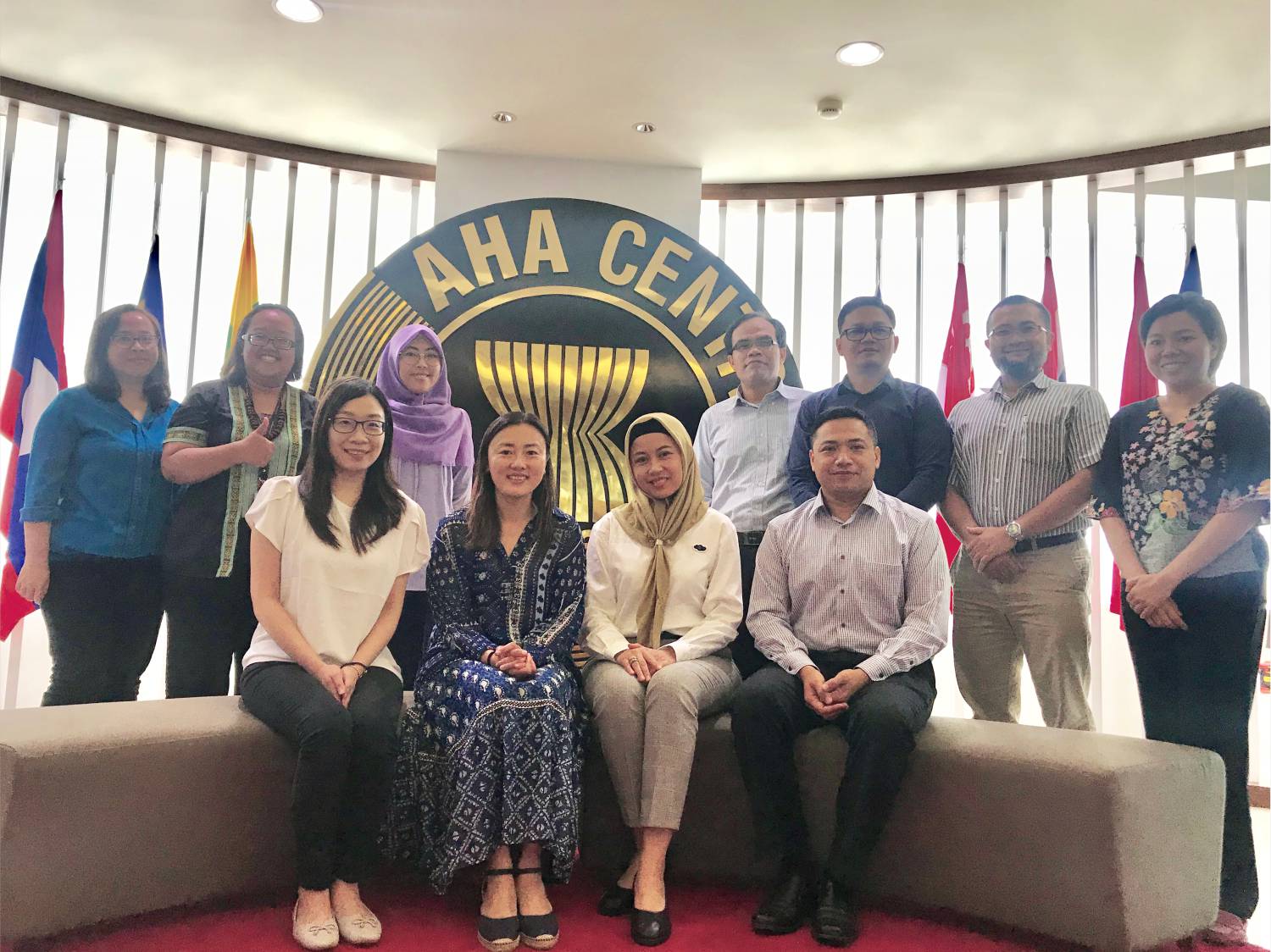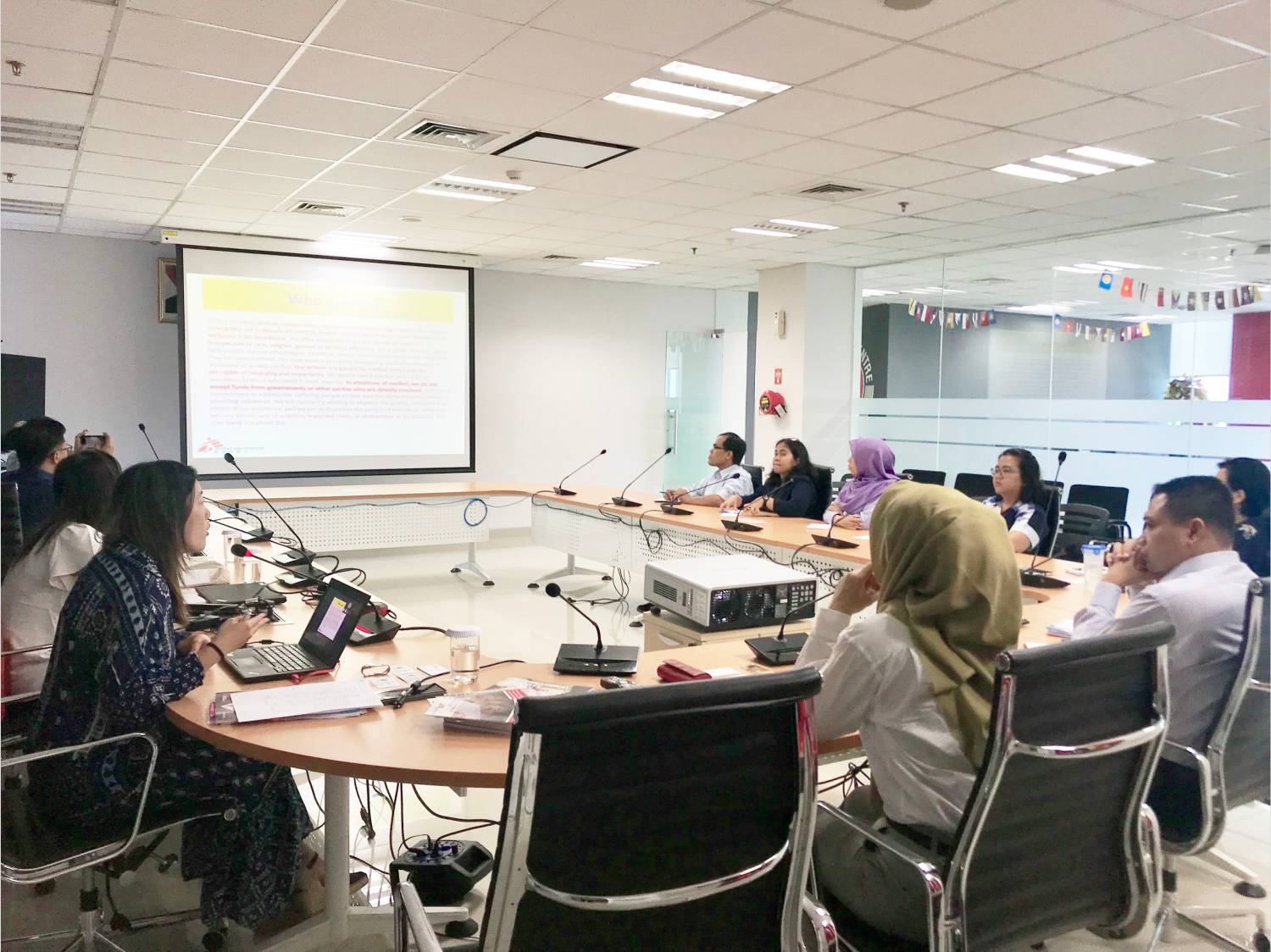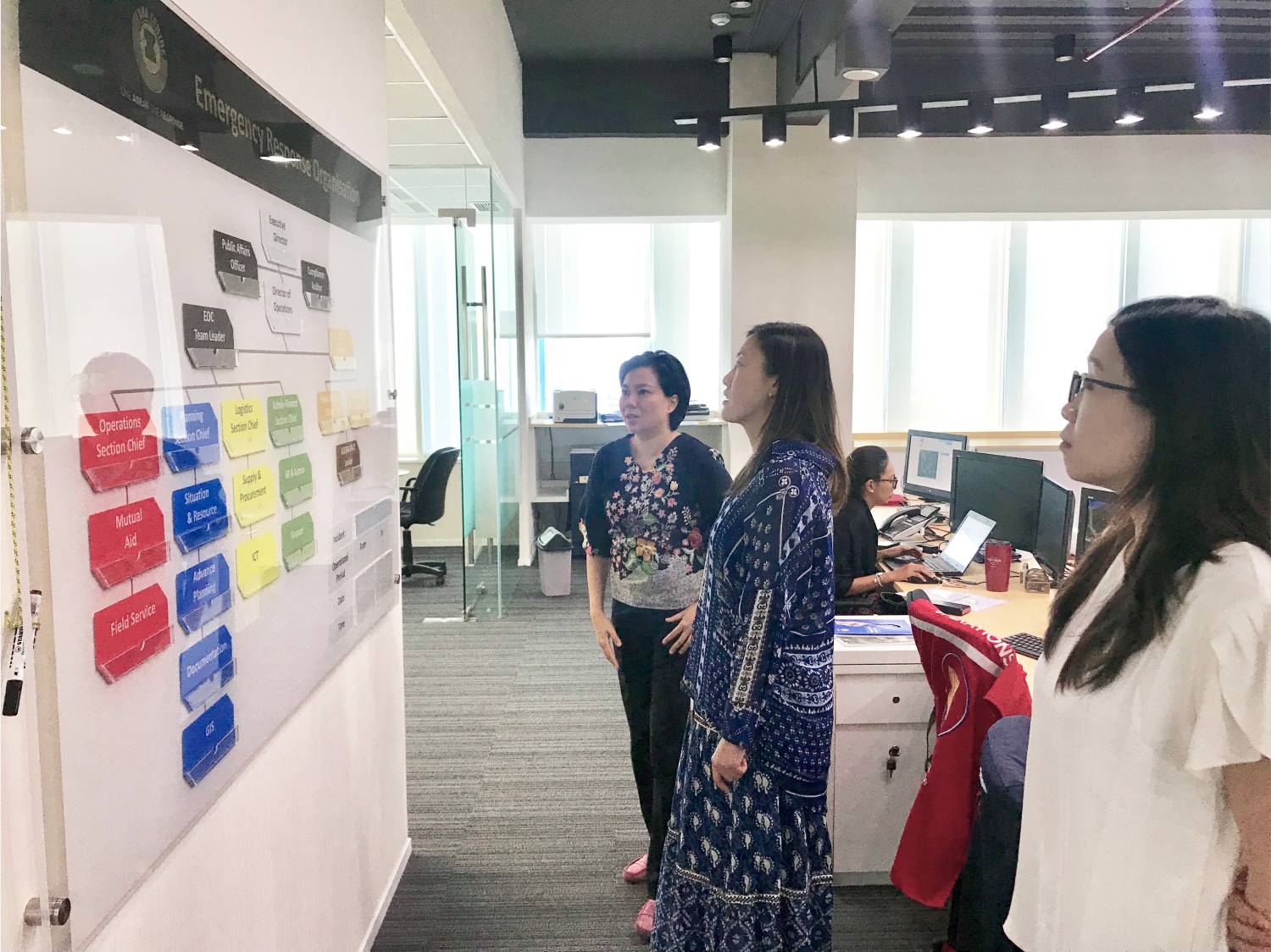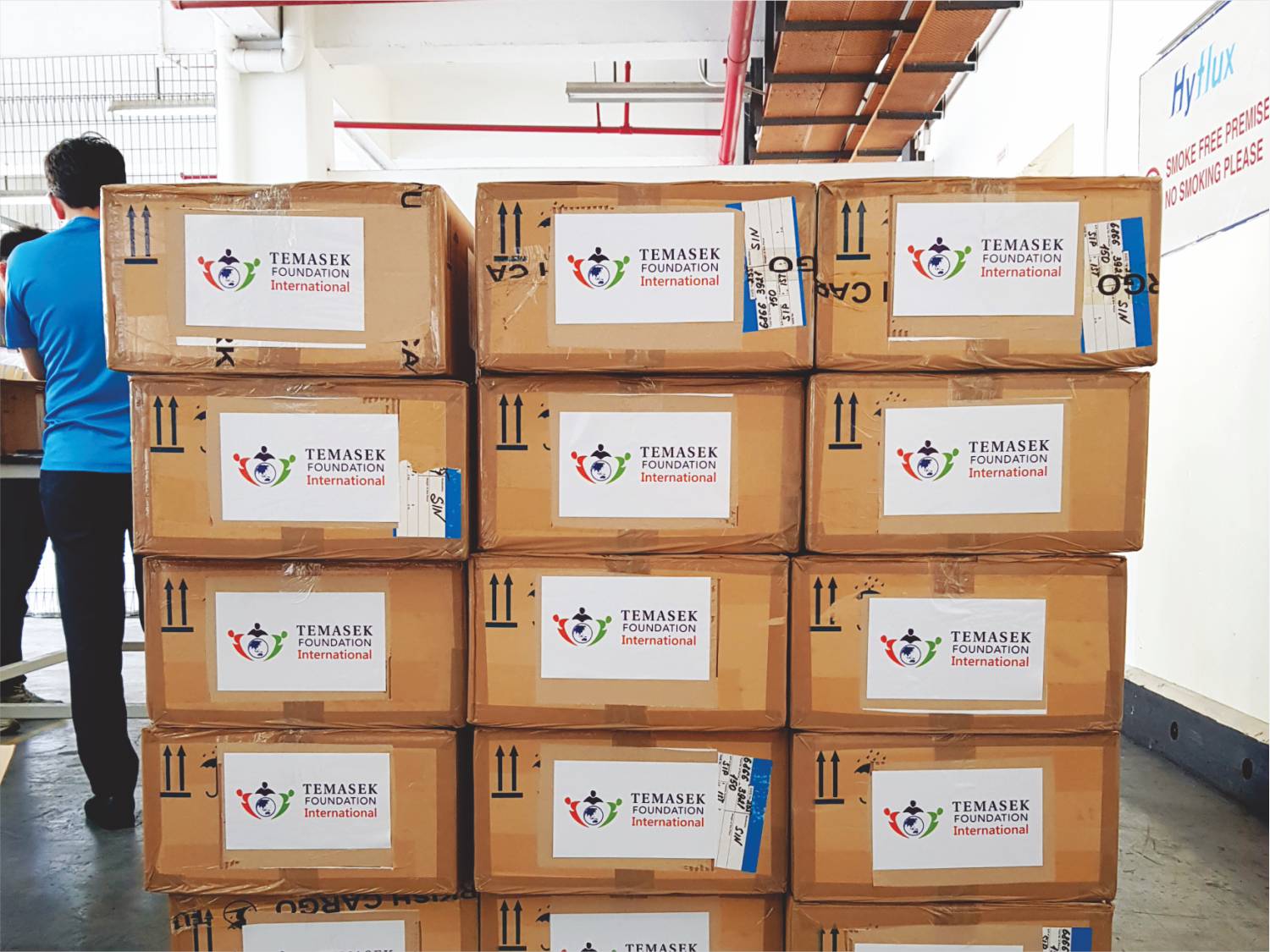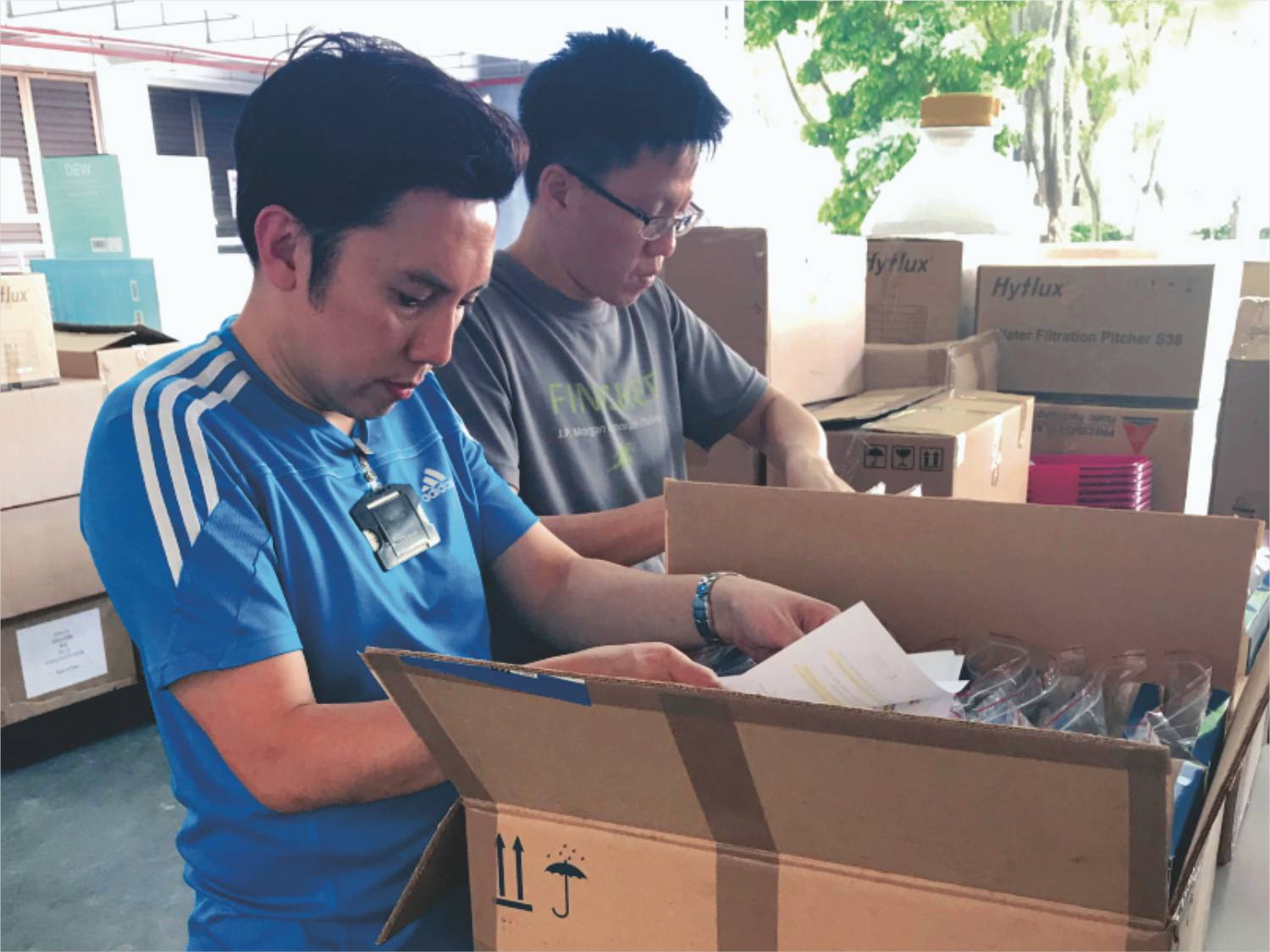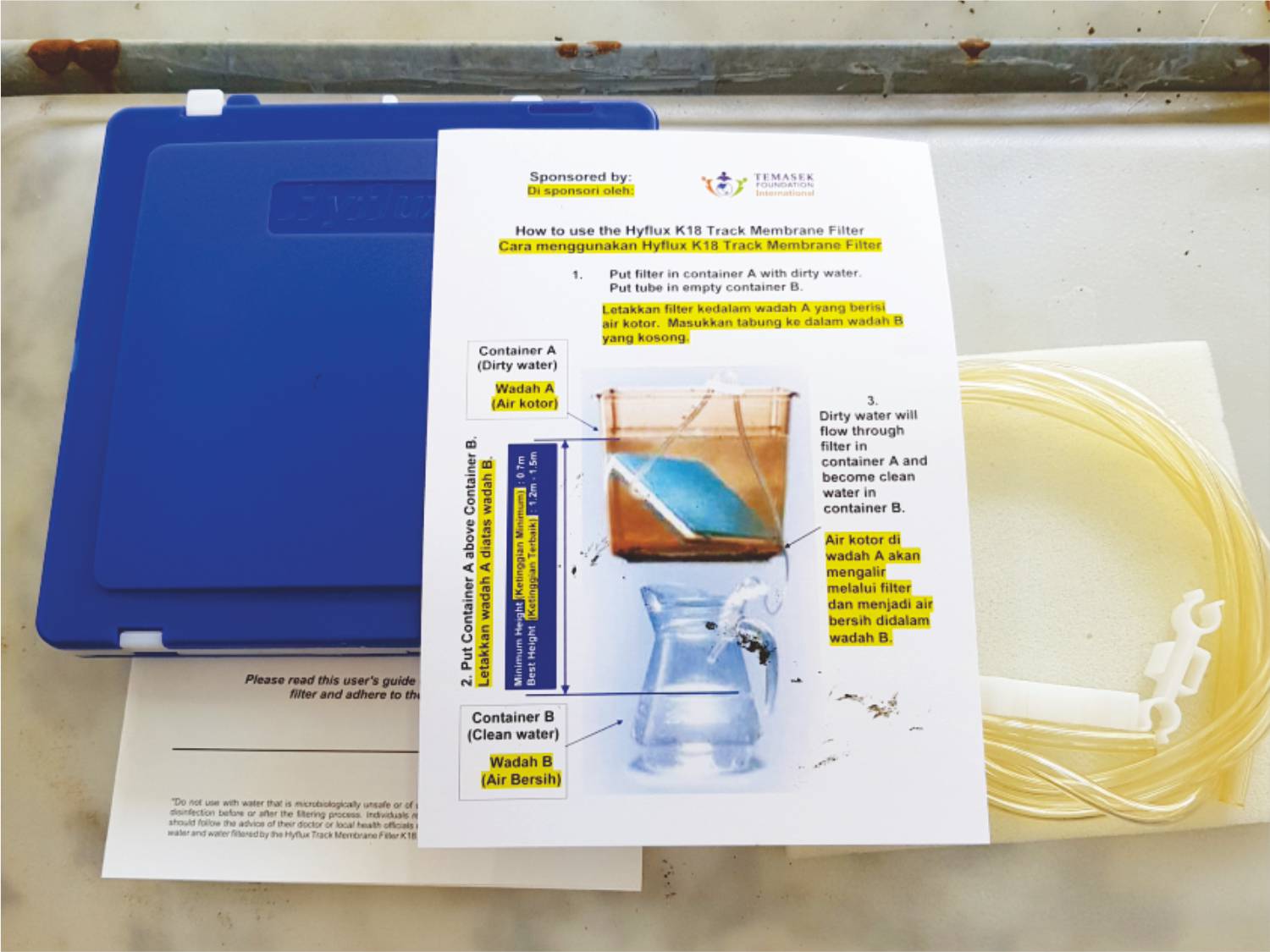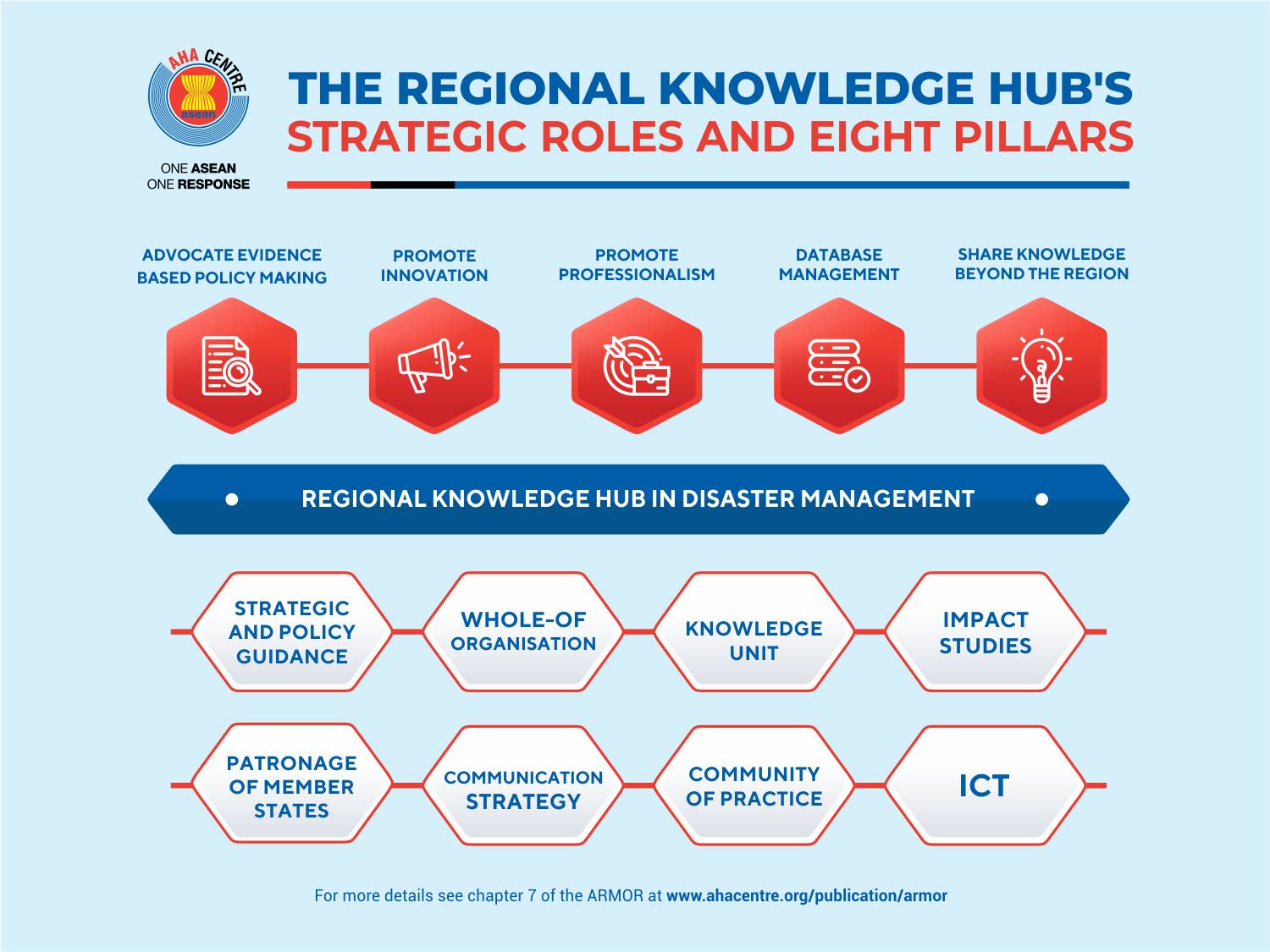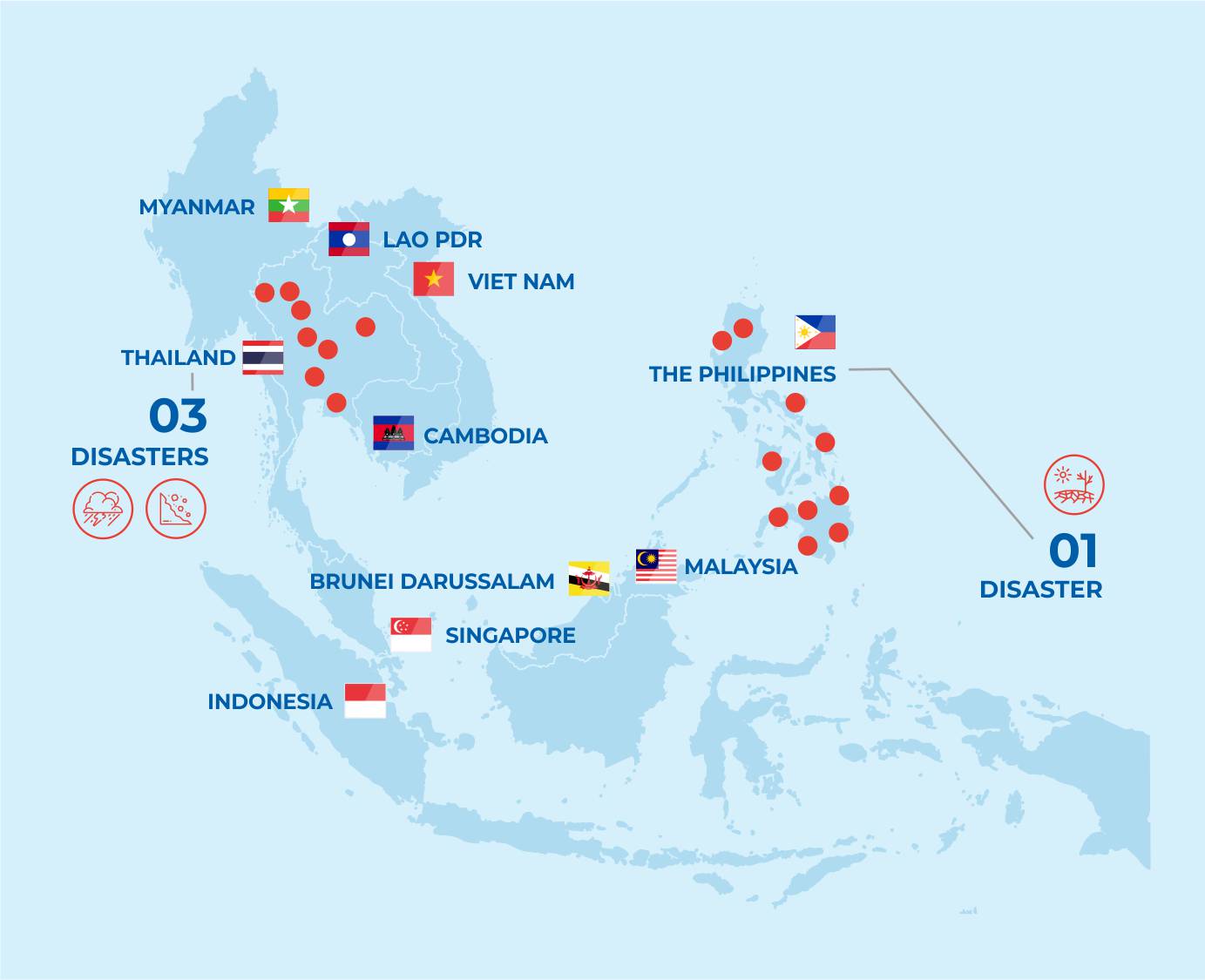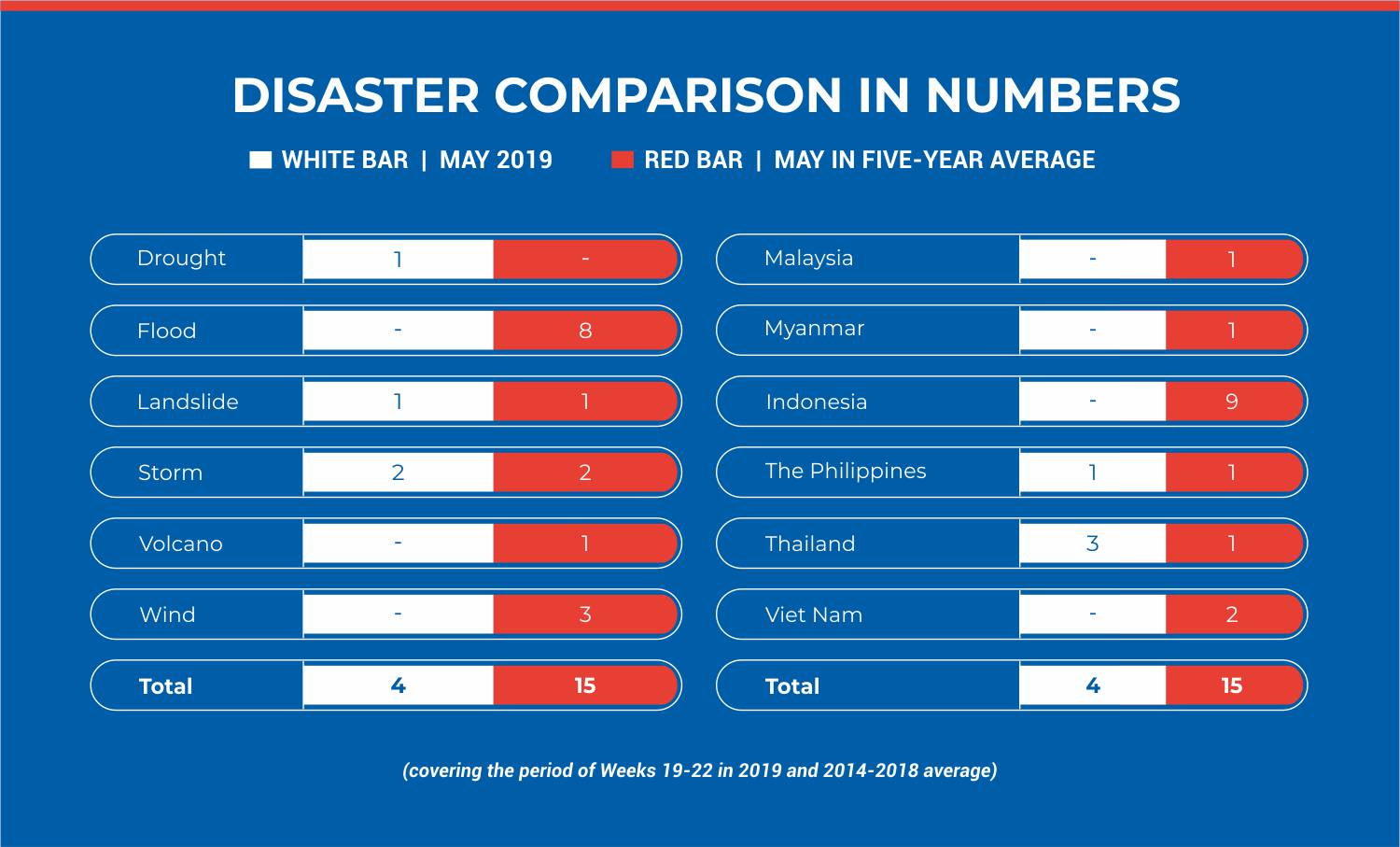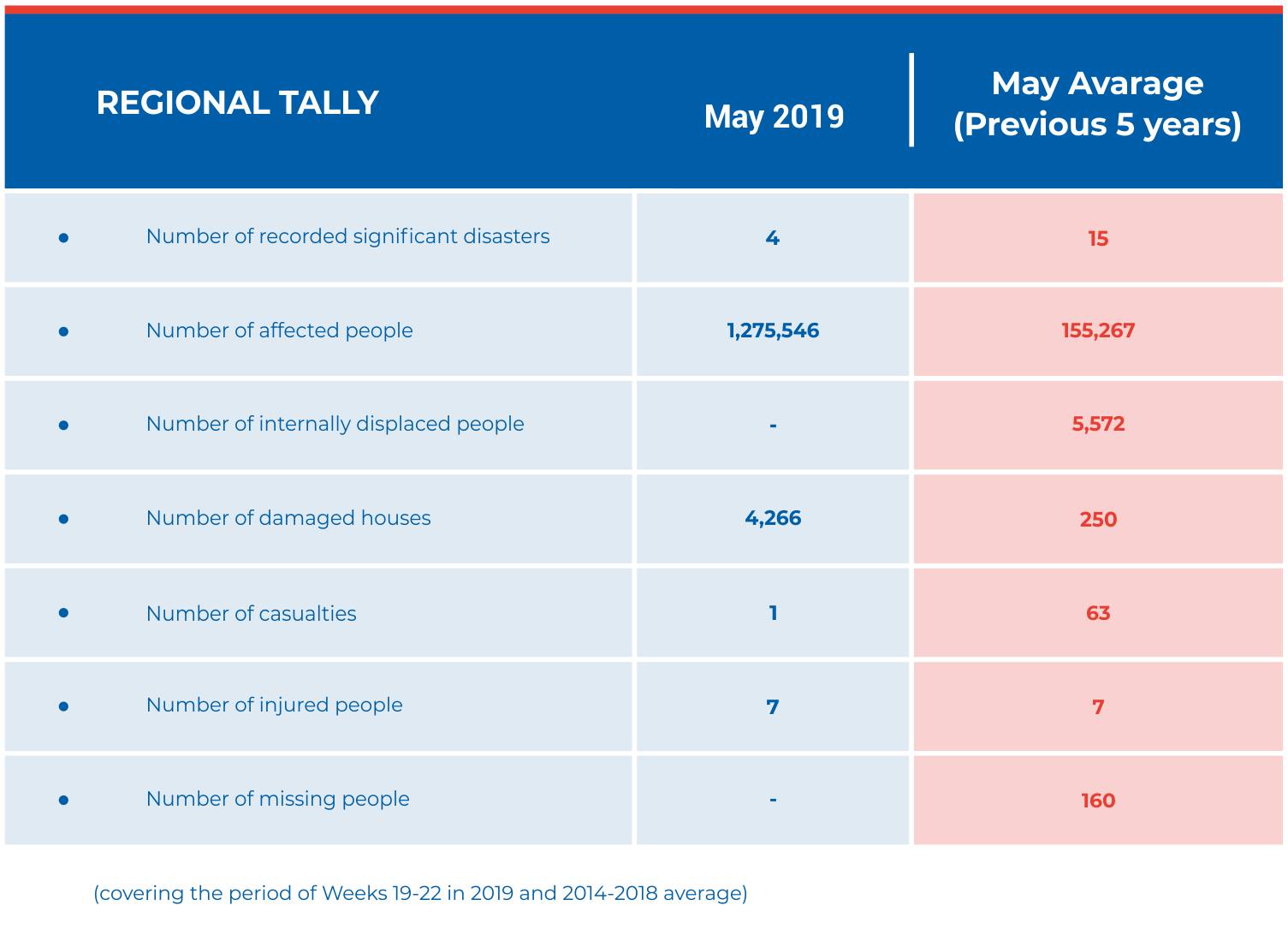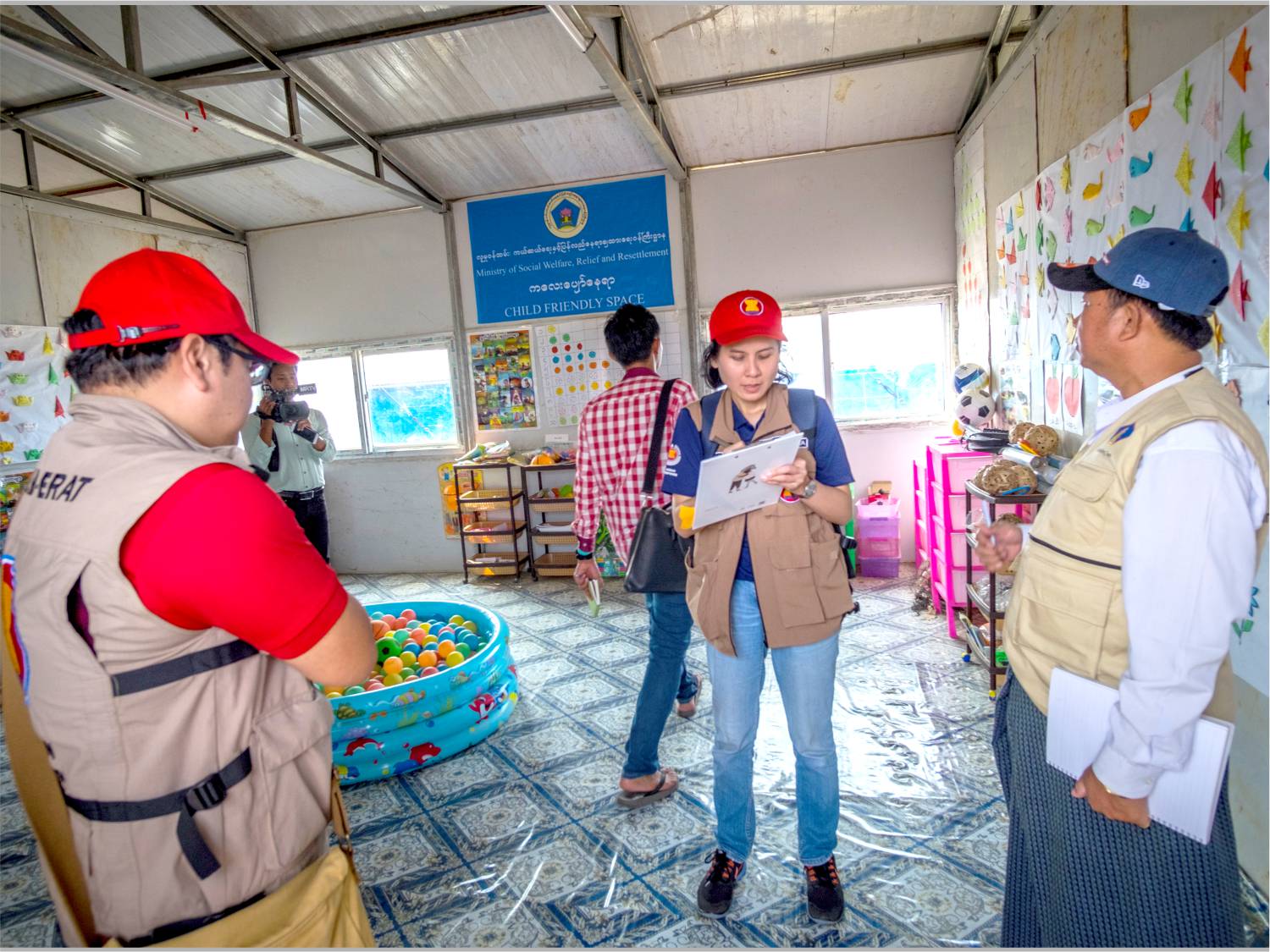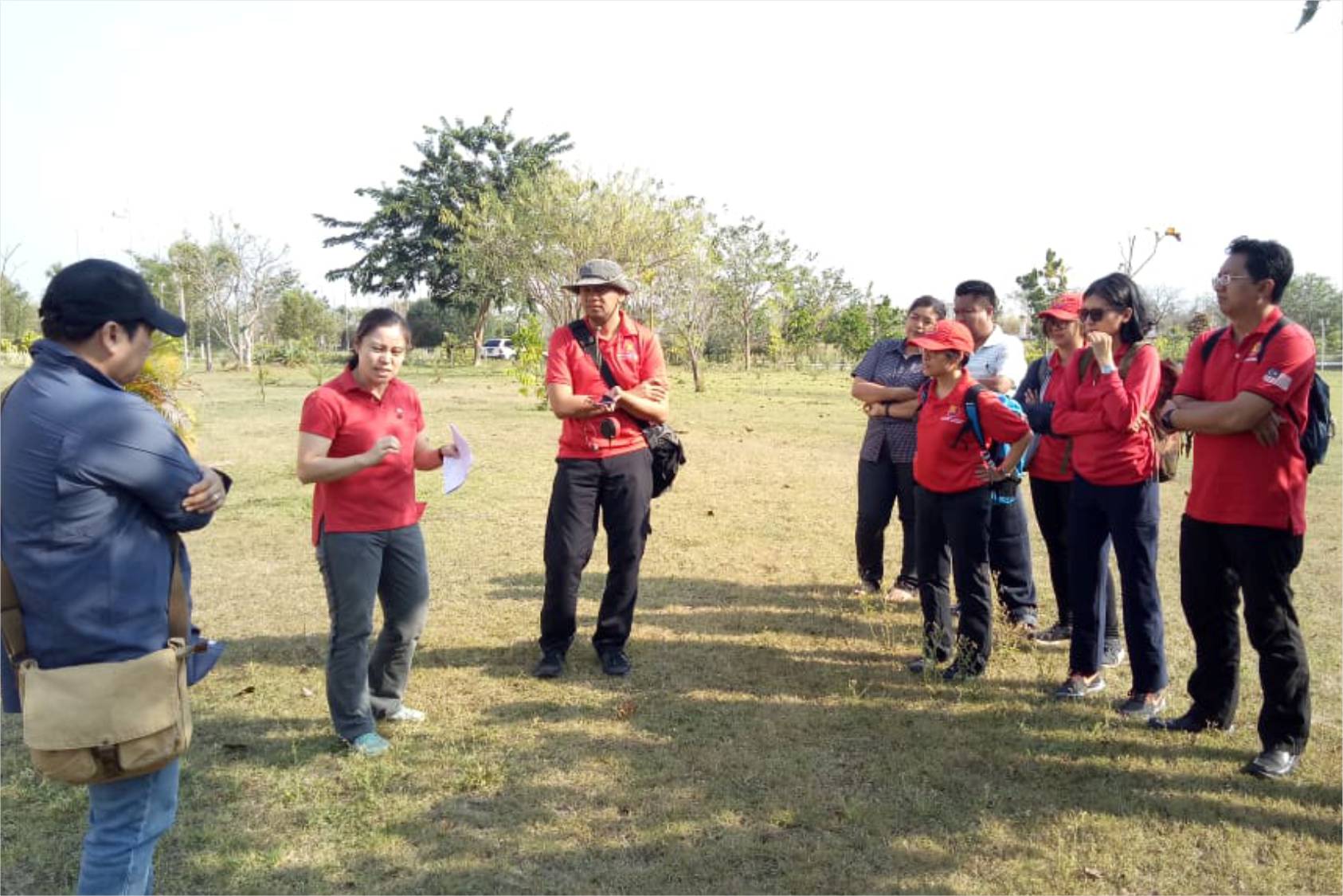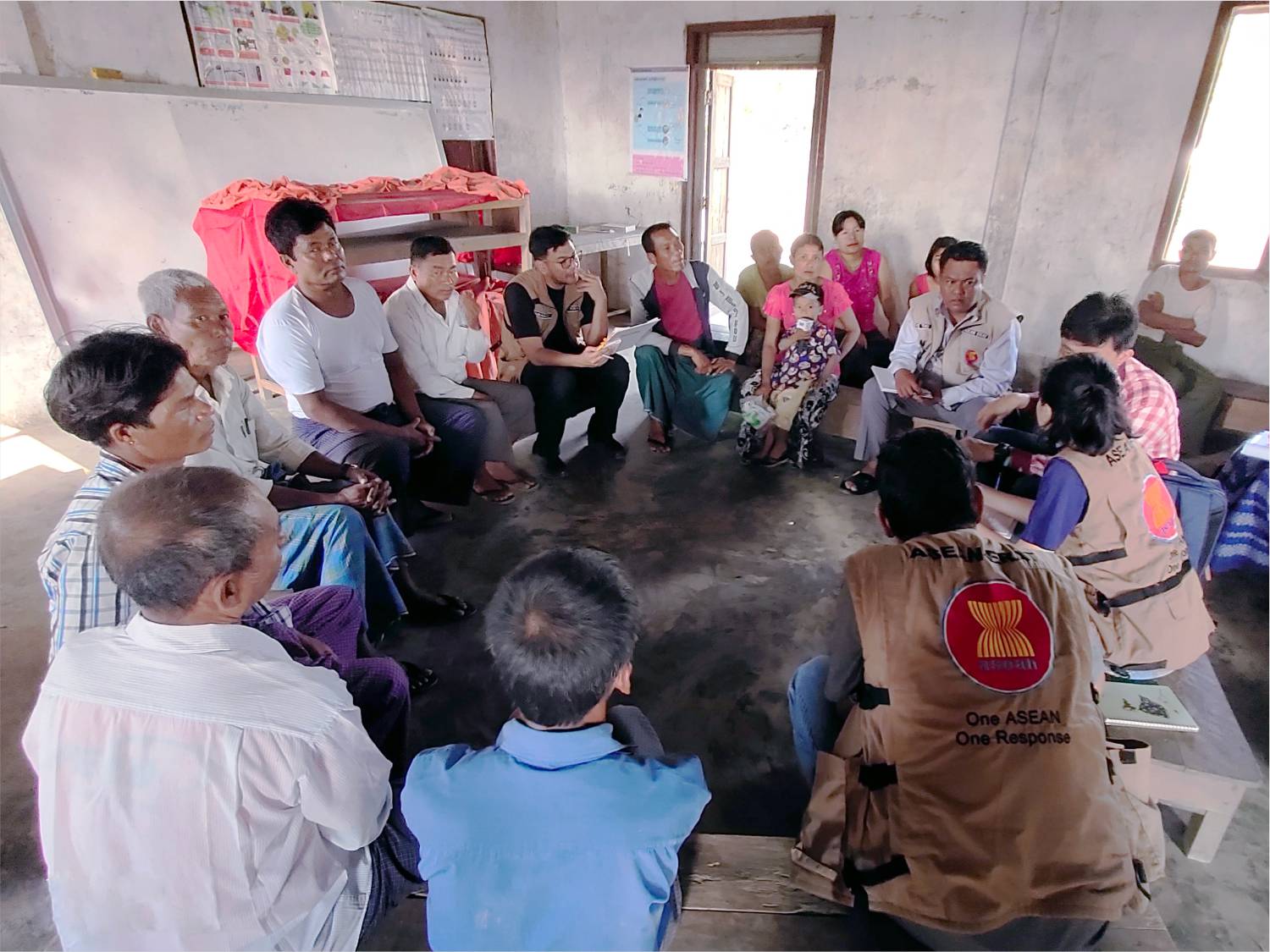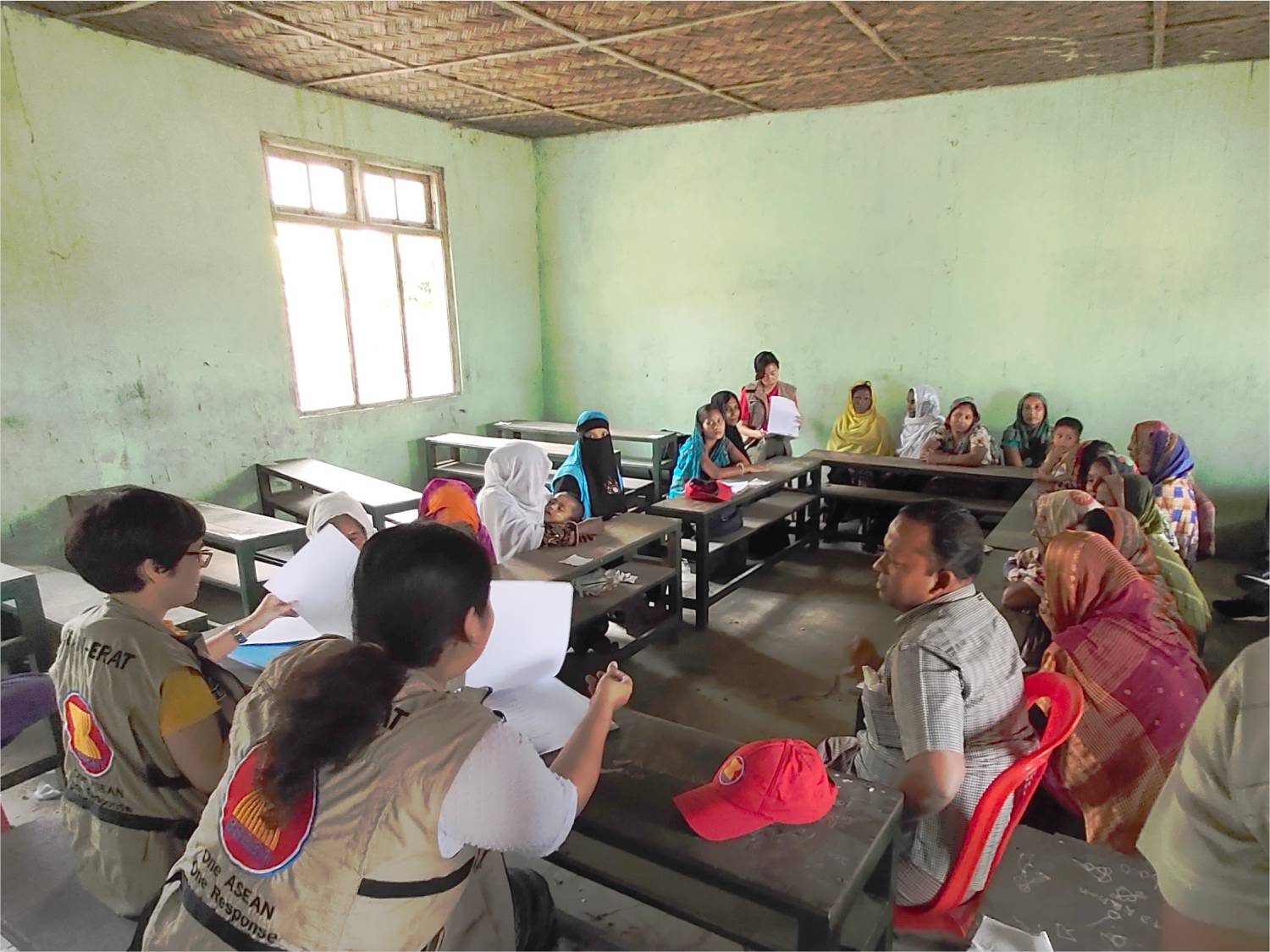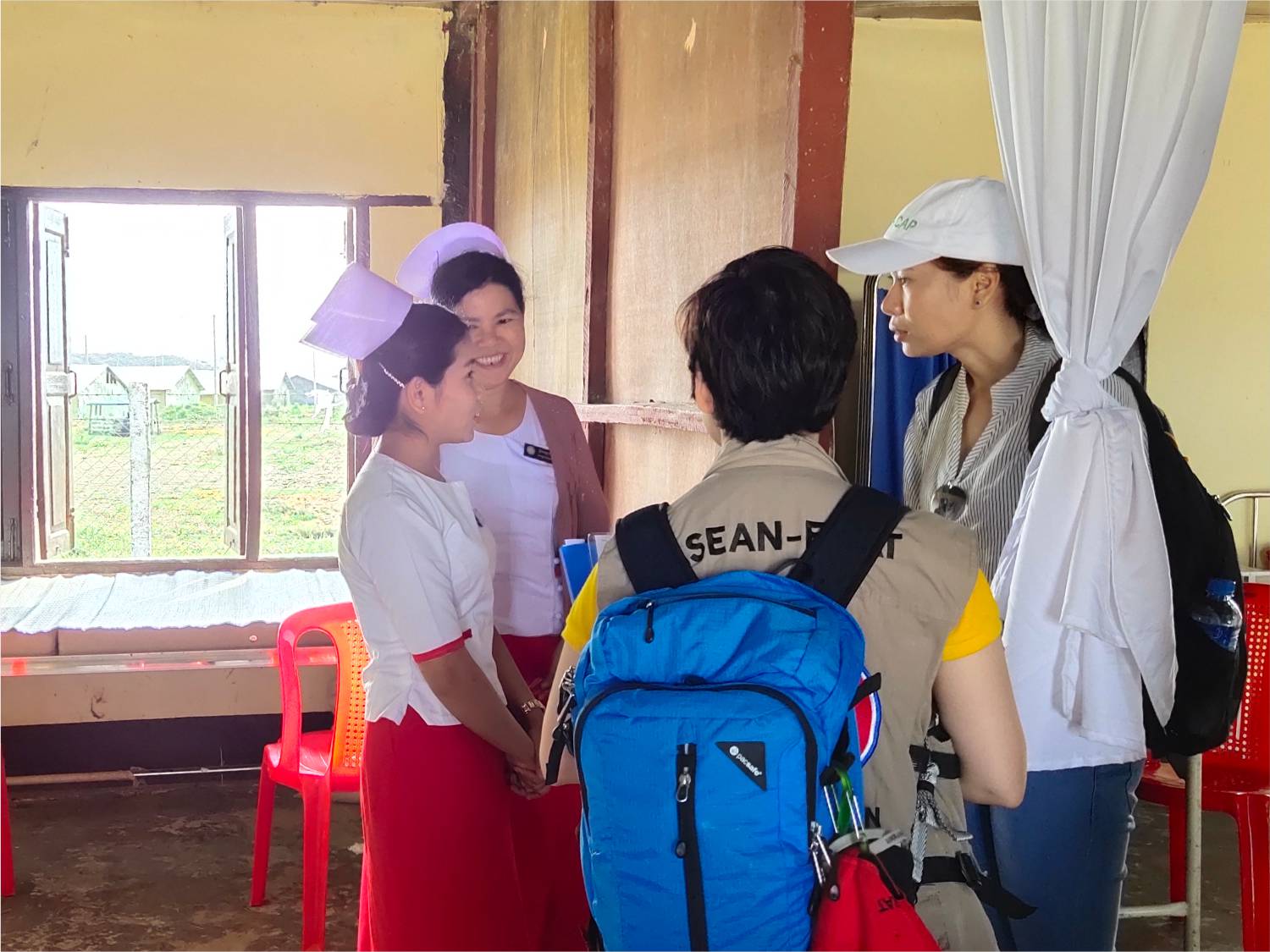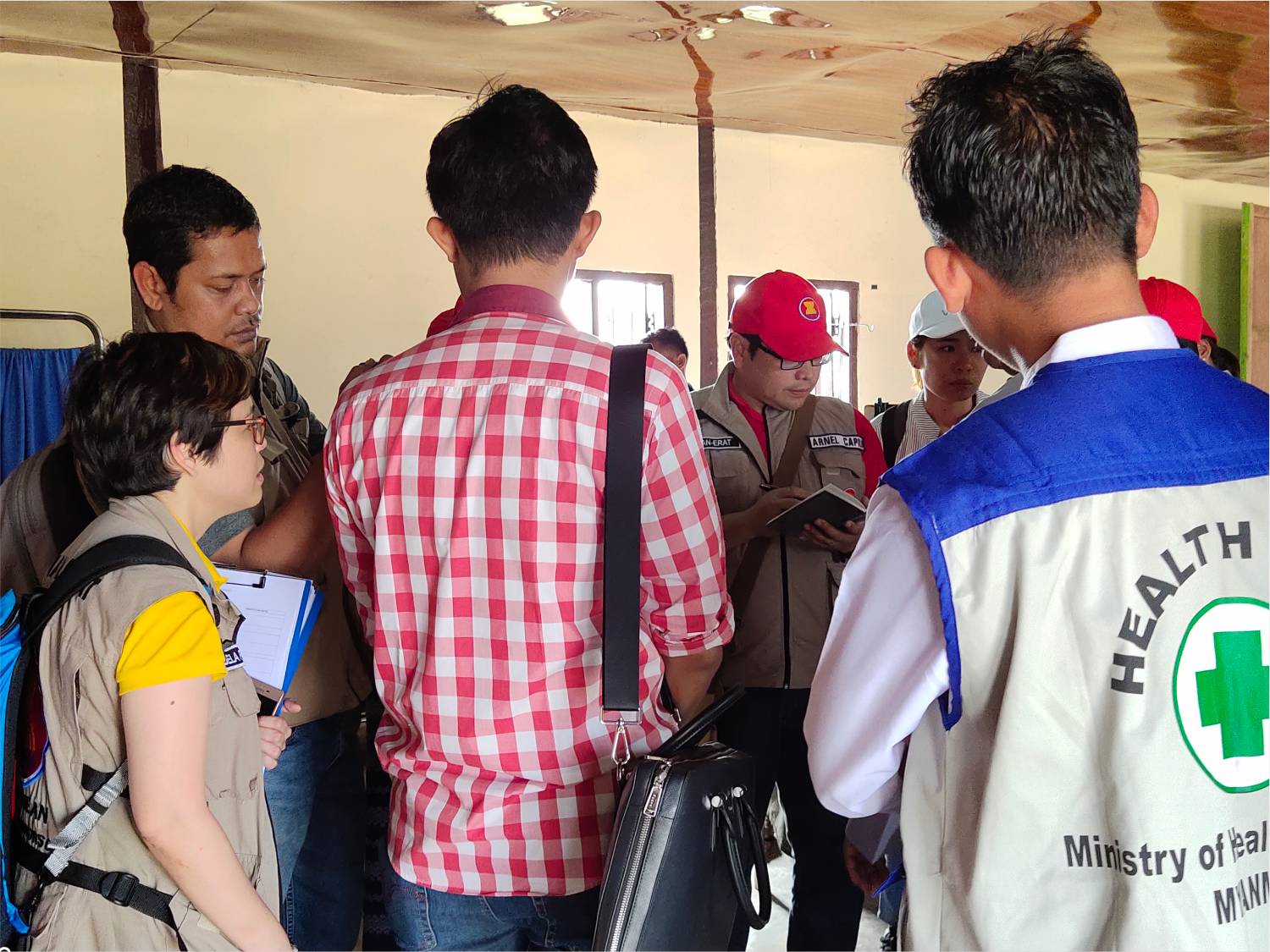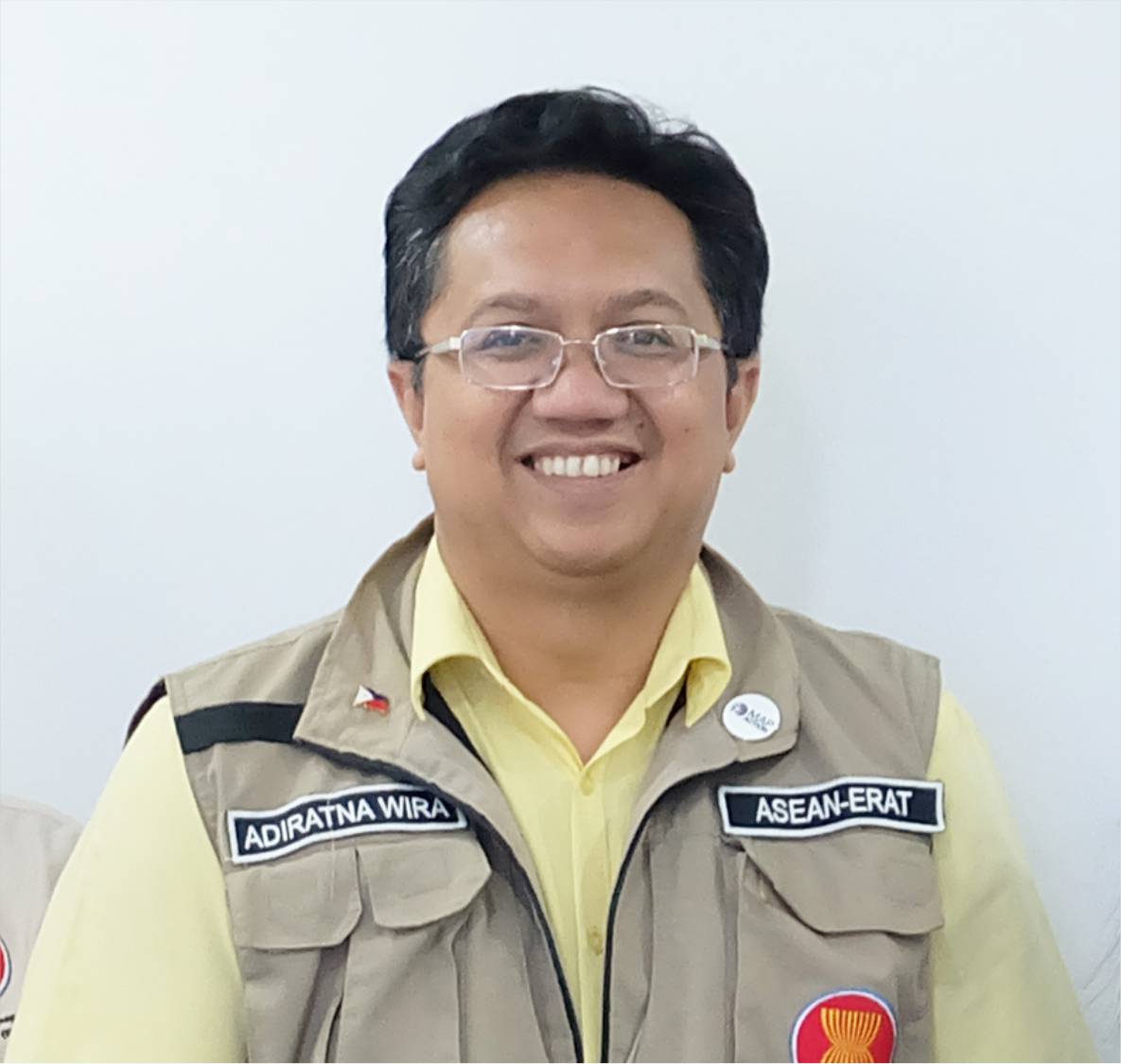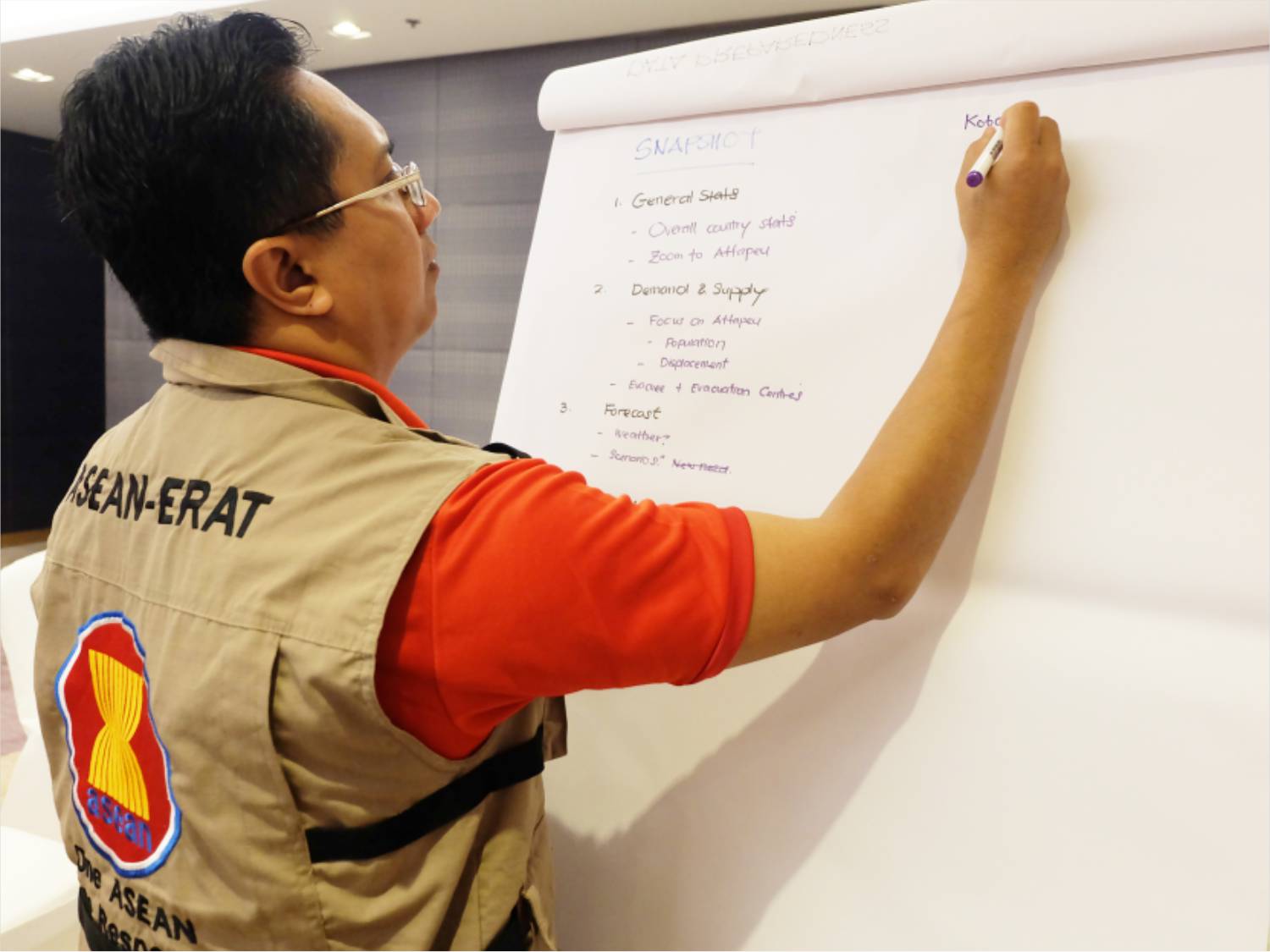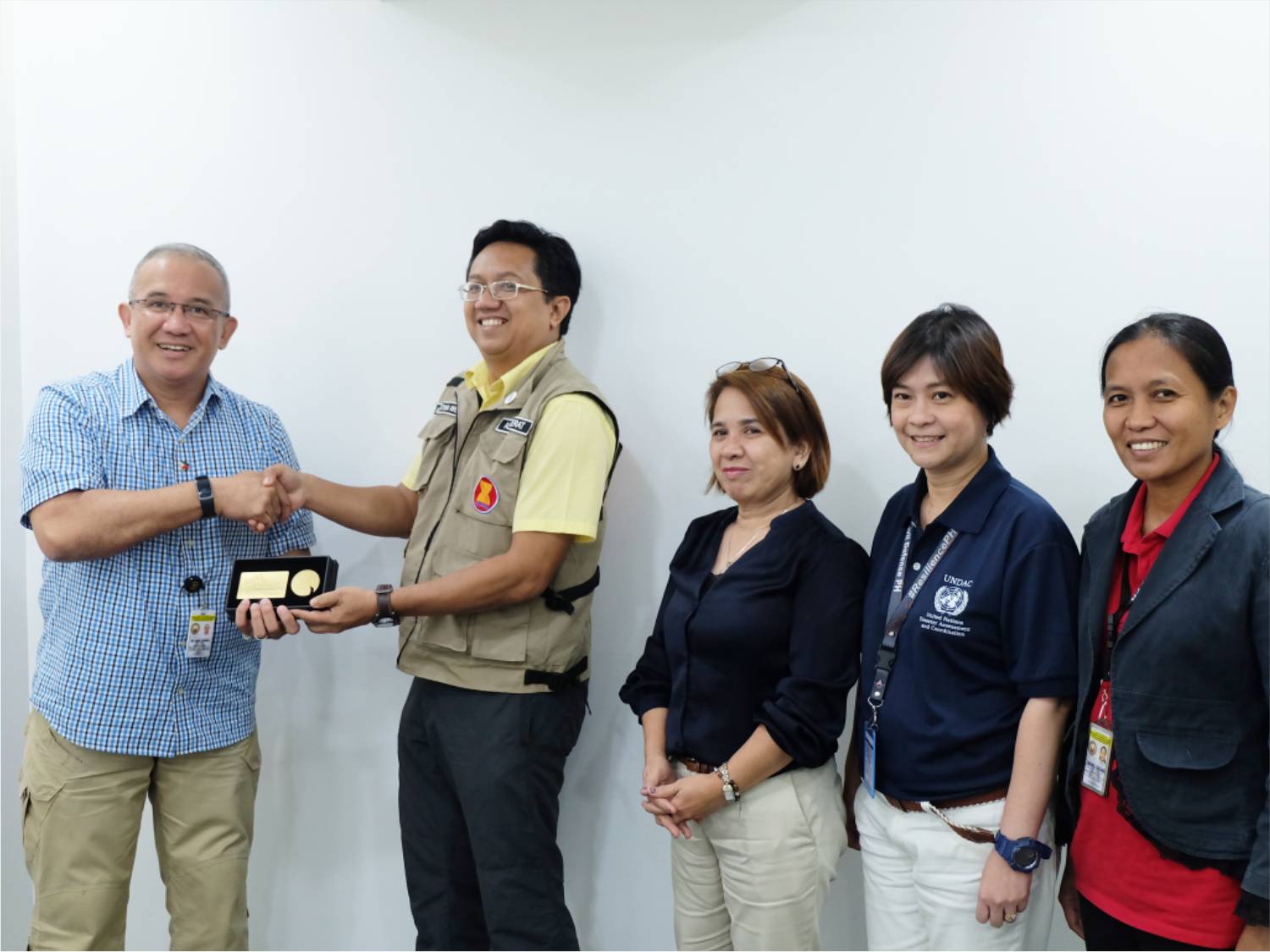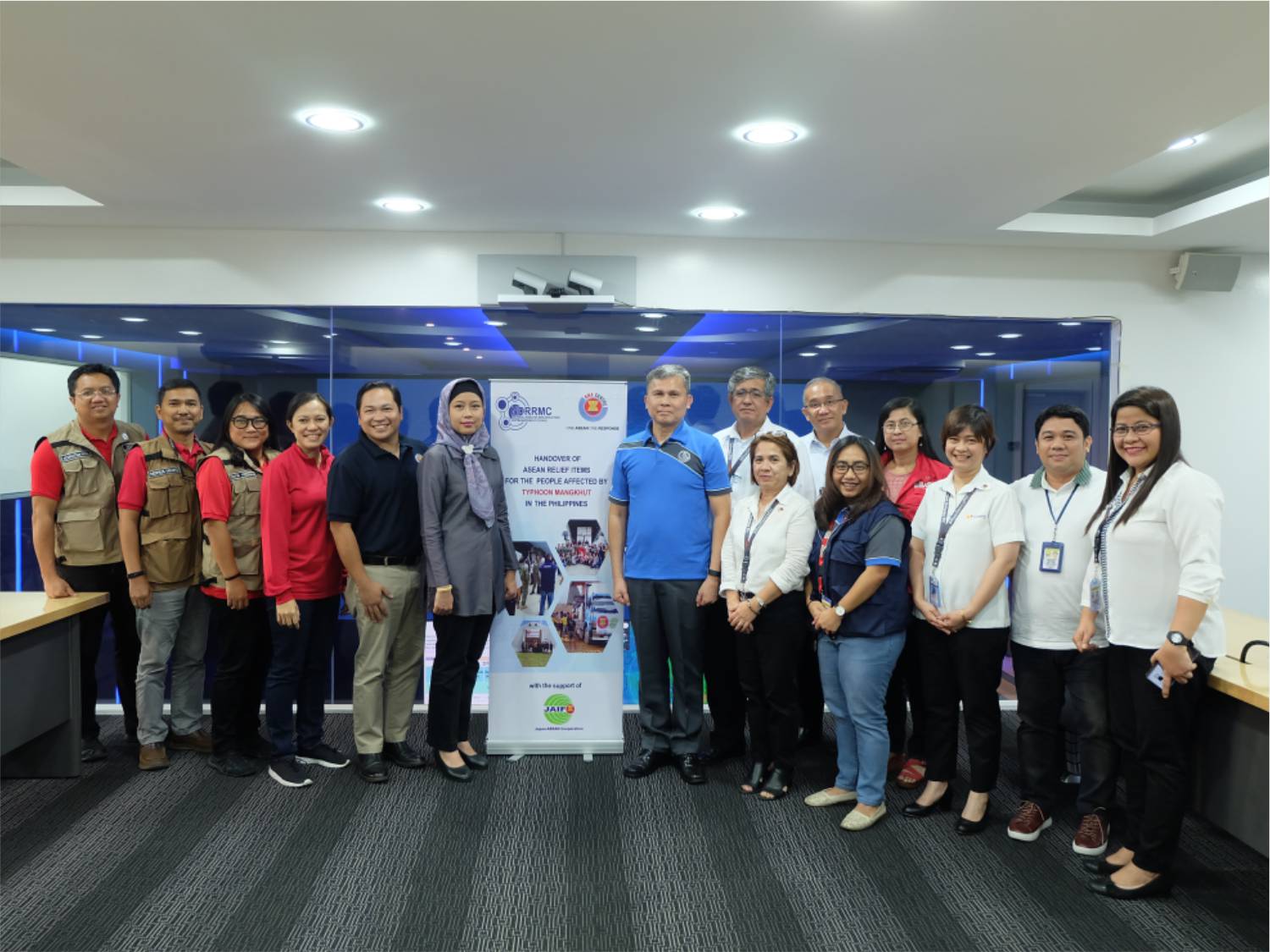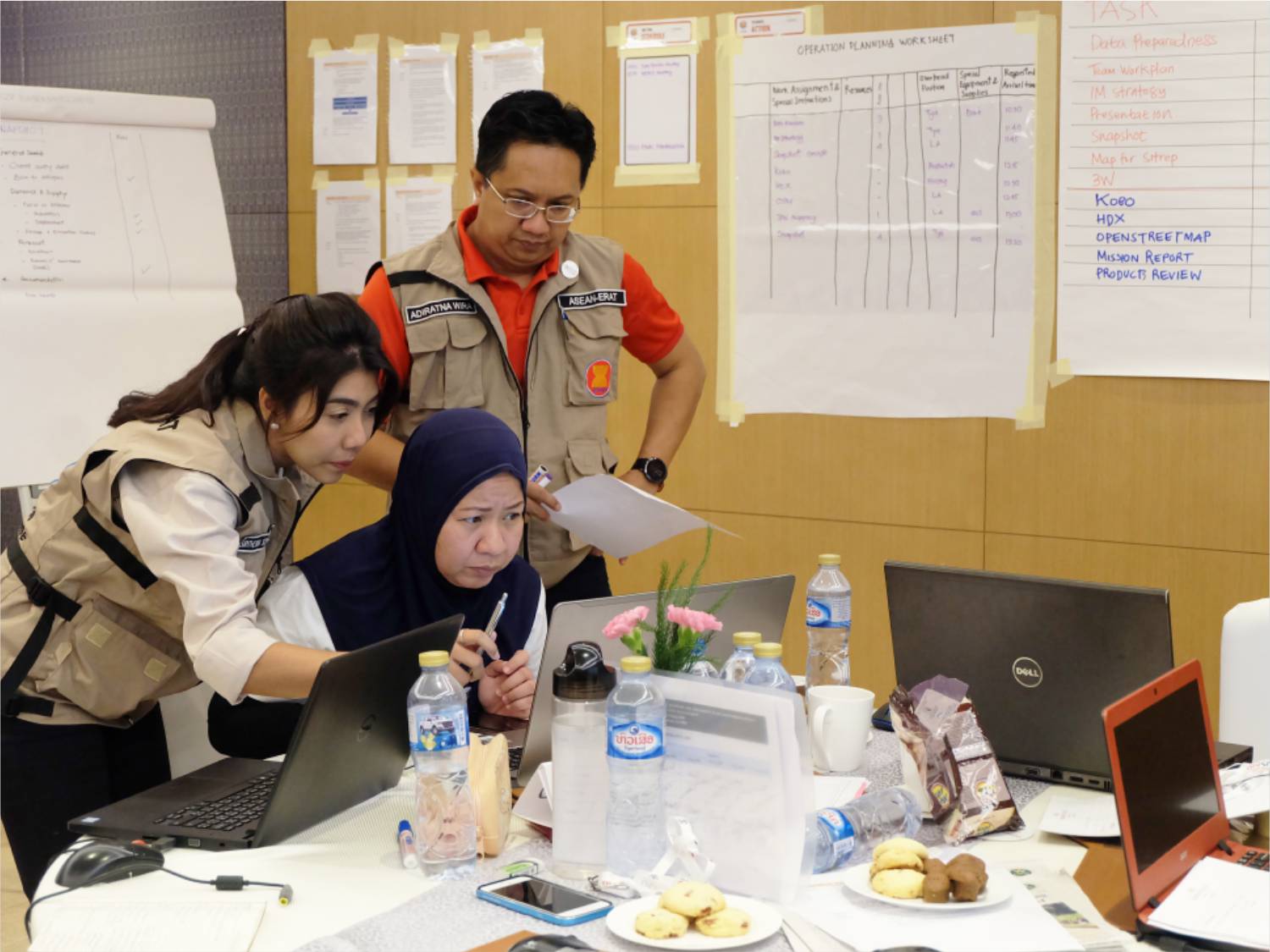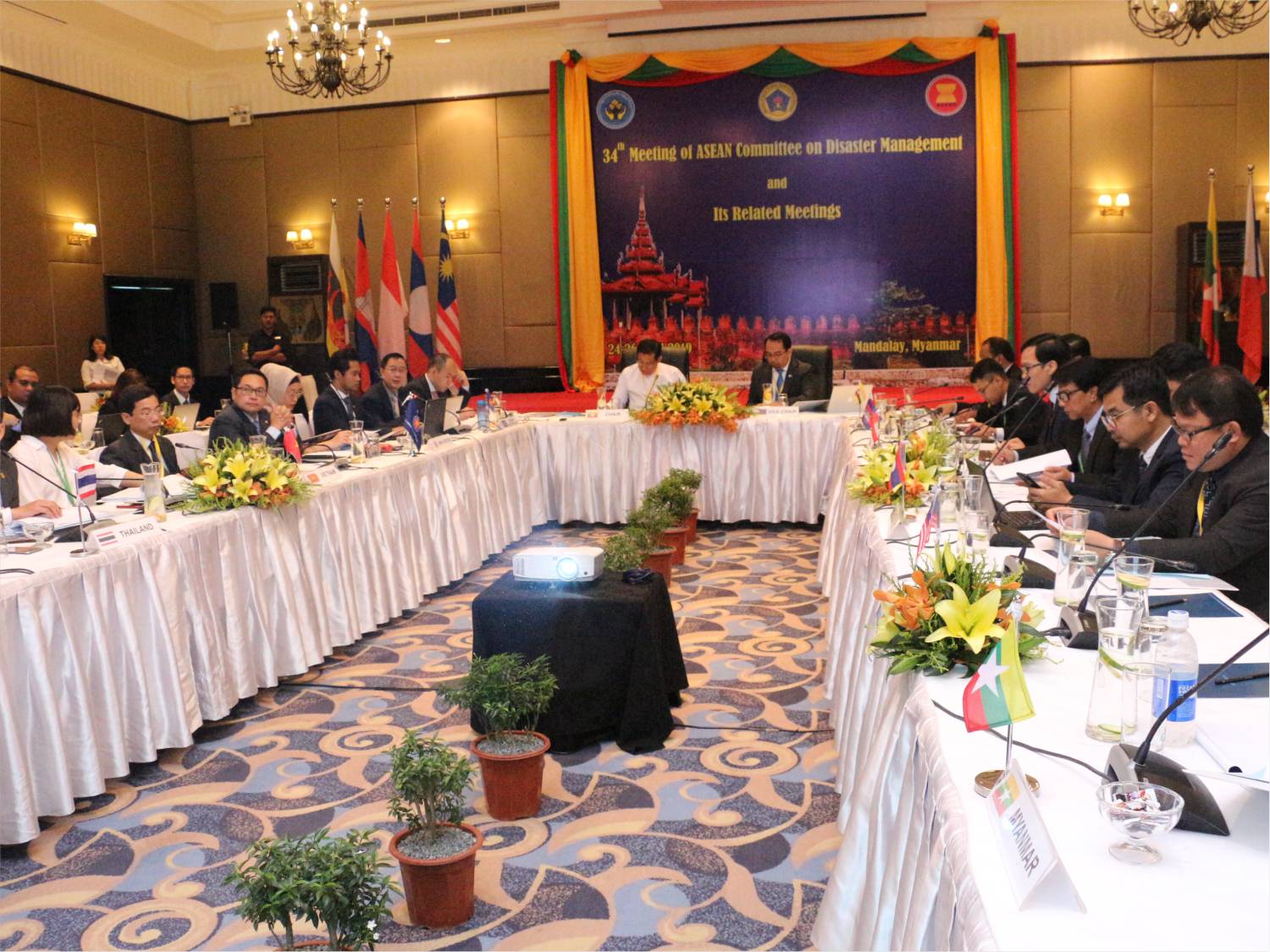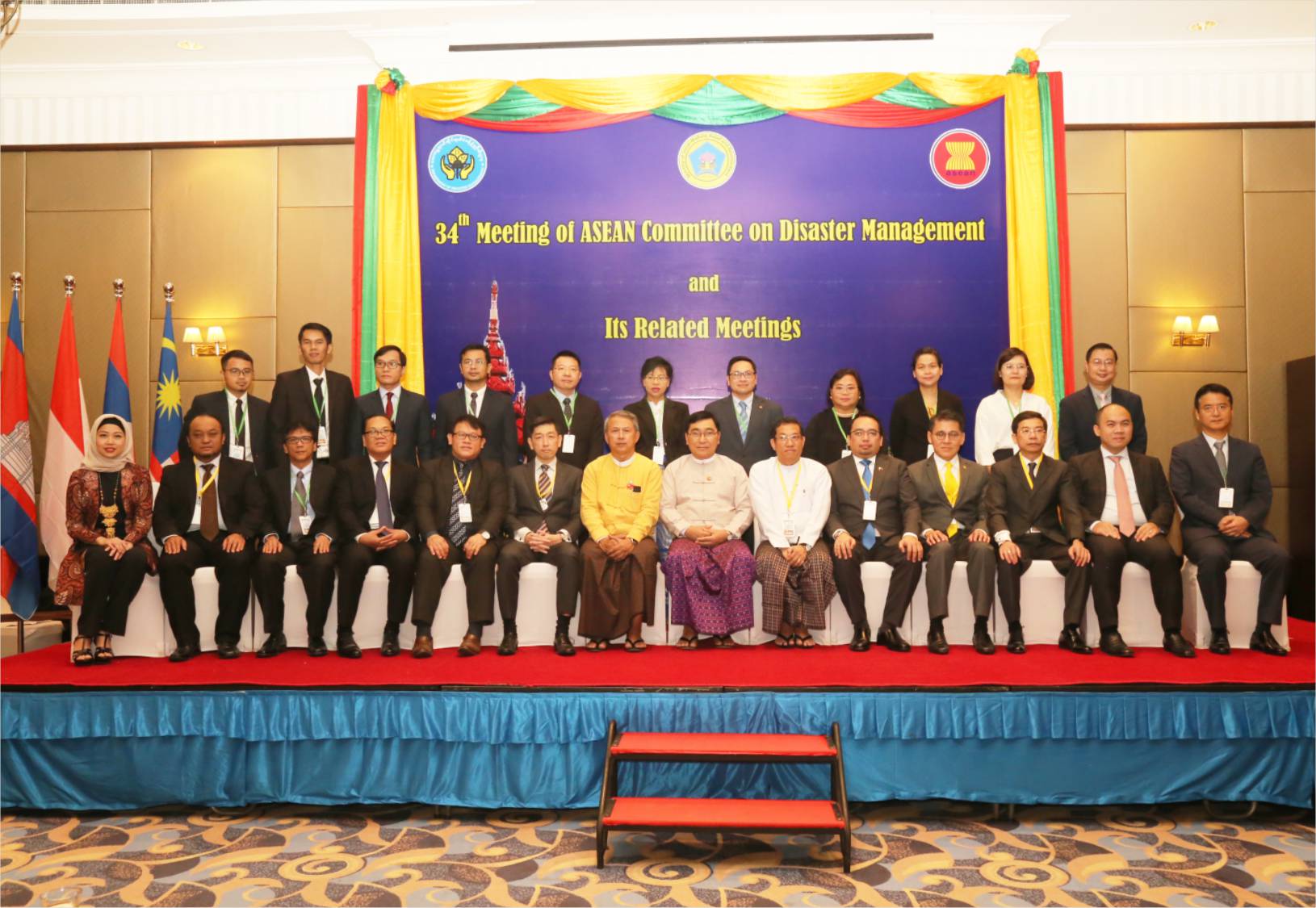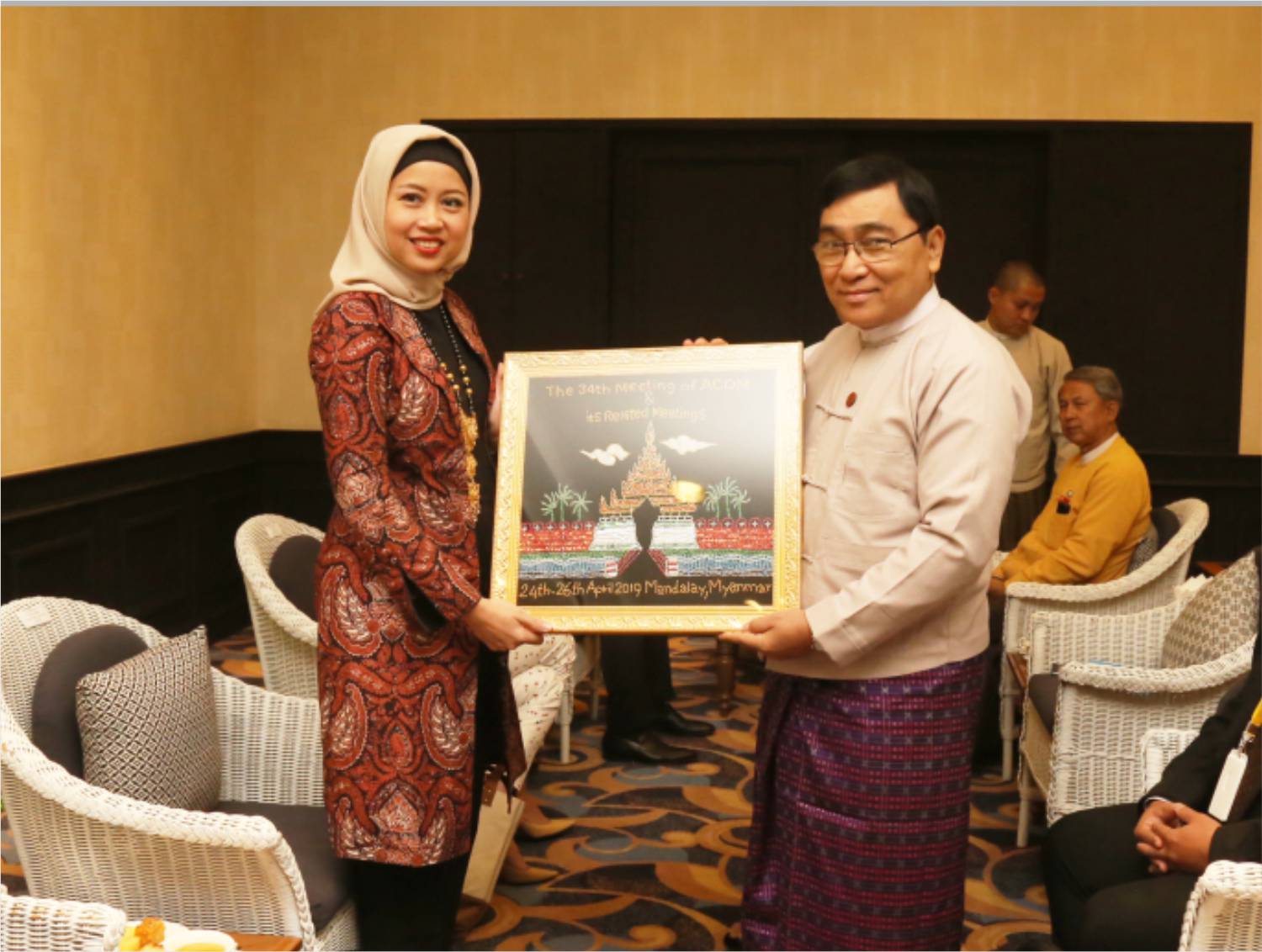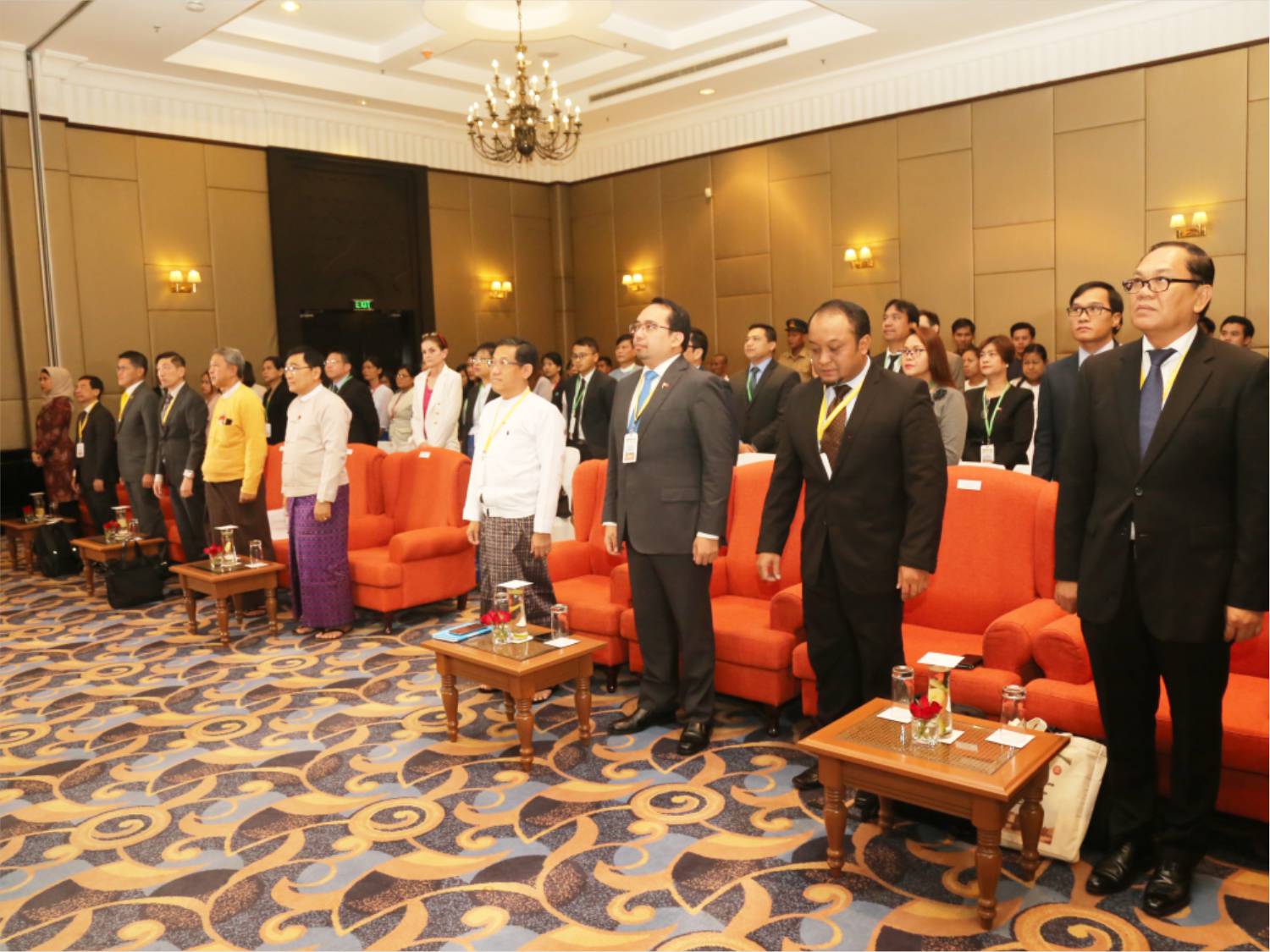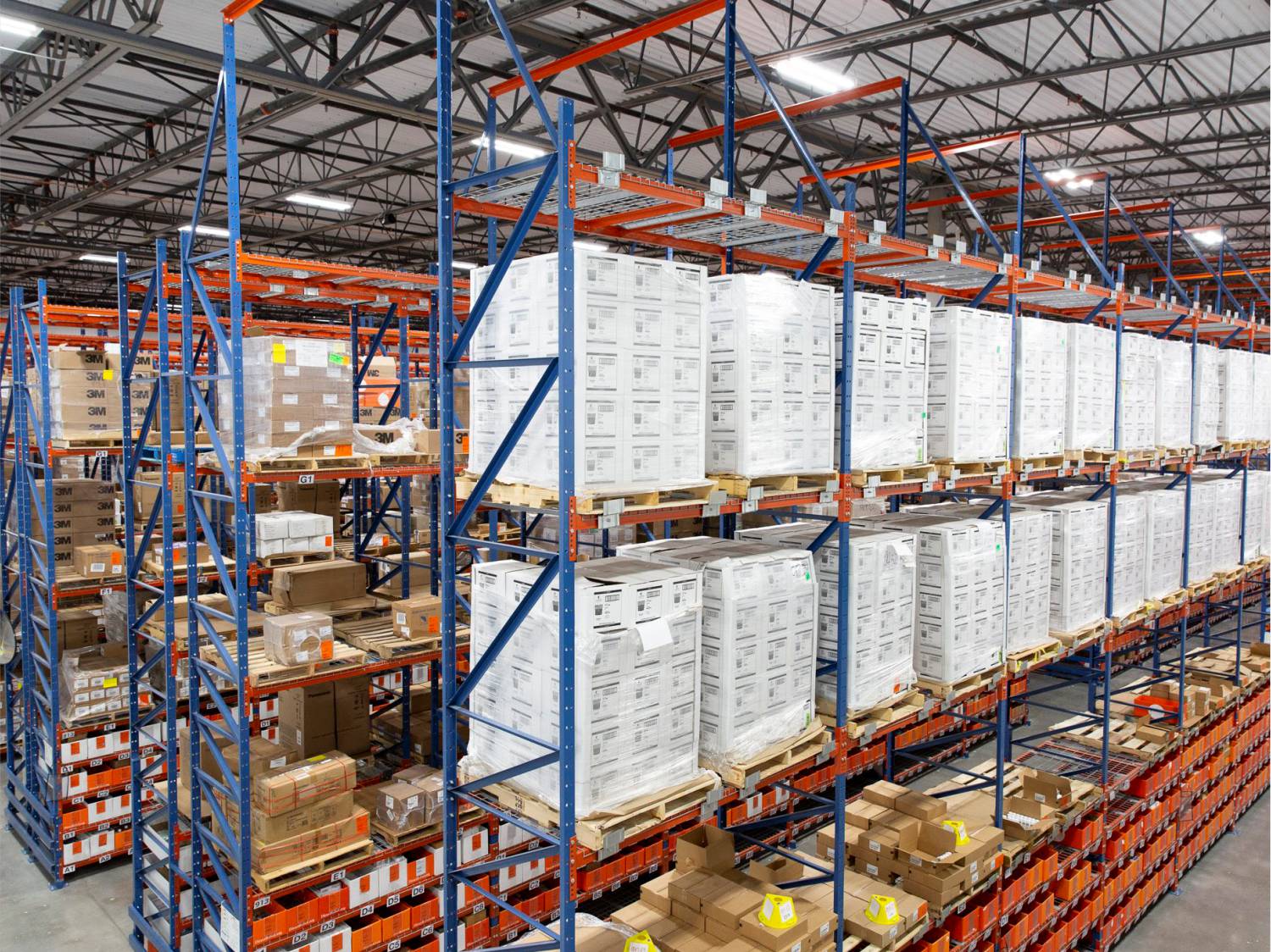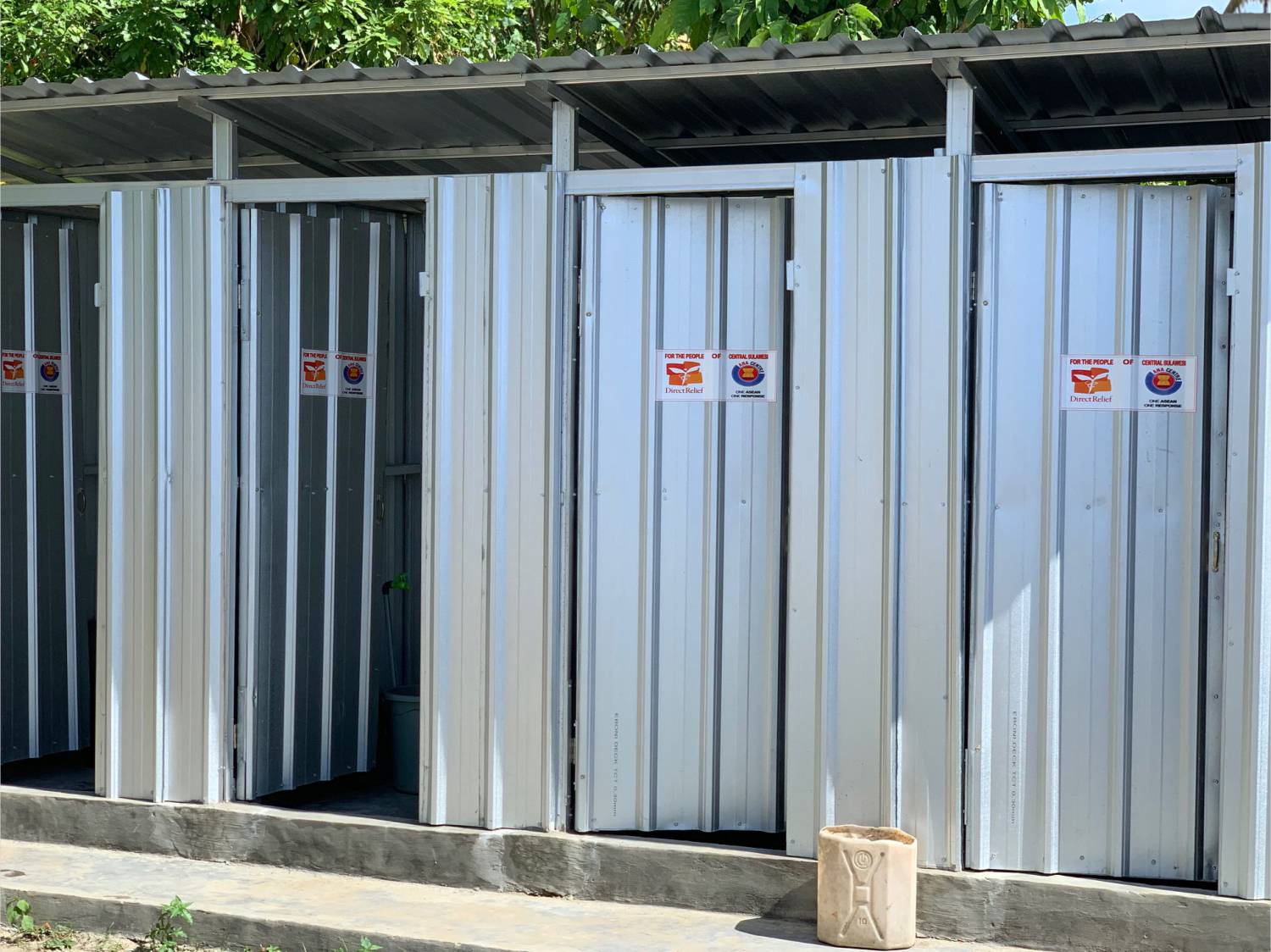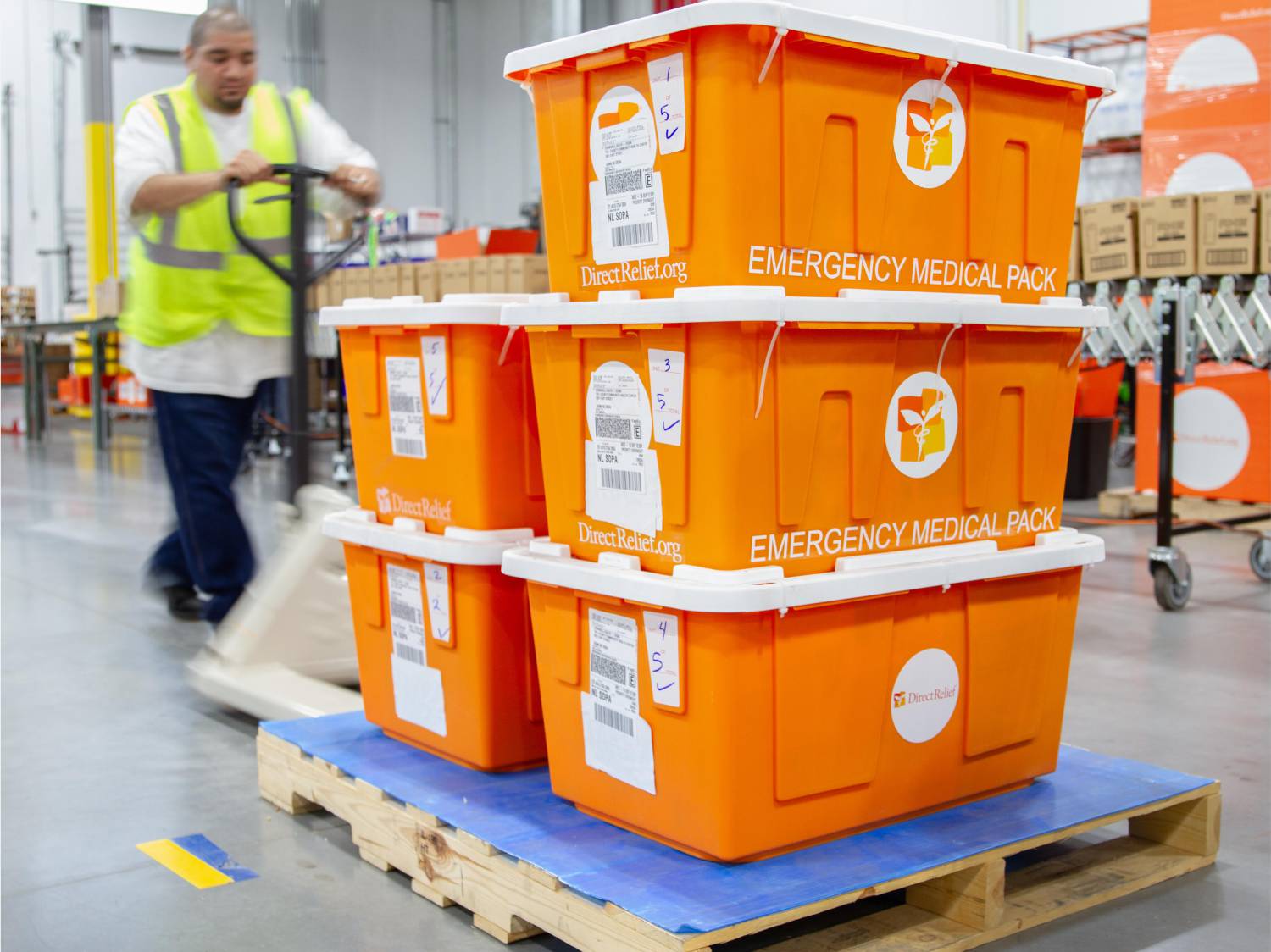Vol 51-MS. MYAT MOE THWE

MS. MYAT MOE THWE
Ms. Myat Moe Thwe’s journey in the disaster management field is one of turning personal experience into passion and desire for advancement. As Director for Coordination and Research Division in Myanmar’s Department of Disaster Management, Ms. Moe is responsible for international cooperation and coordination on disaster preparedness, relief, response and recovery for the nation. Her busy schedule sees her coordinating between local and international disaster management organisations on the development and implementation of policy and guidelines, undertaking disaster risk management research, and also being Myanmar’s go-to person for the nation’s ever-expanding engagement in the regional One ASEAN One Response movement.
It was, however, a more personal reason that ignited Ms. Moe’s passion for all things disaster related. Experiencing the full brunt of Cyclone Nargis when it stormed through Myanmar in 2008 not only affected Ms. Moe directly, but also voluntarily participated in the emergency relief and response operations and family reintegration programmes that took place in the days, weeks and months following the significant disaster. “The needs were so immense and broad at the time” Ms. Moe recalls, “but resources were very limited. There were very few organisations who could support early disaster relief, and even many of the responders ourselves were also victims of the disaster”. While providing whatever form of physical and emotional support she could, the engagement of numerous international disaster management organisations in the time following the disaster saw Ms. Moe involved in training and capacity building ‘on-the-ground’, that allowed her to learn more about what she had just been involved in, and learn lessons about disaster management on a daily basis.
“Experience is the best teacher – and learning from experience is the most important tool for individual development” says Ms. Moe.
“There were mistakes that I made during that very first experience due to the lack of knowledge and skill in dealing with disaster. However, this in turn drove my passion to learn more about disasters, and further pursue skills in disaster management.”
When taking about the present – and the future – for disaster management in Myanmar and the ASEAN region, Ms. Moe is quick to highlight the importance of technology to support improved preparedness and response for the communities. She identifies the important role of technology, and how it can support increases in human capacity for disaster management practices. “We have ideas and experience related to disaster management, but they need to be combined with technology for increased outreach and speed”, explains Ms. Moe. “By doing so, our valuable ideas can be transformed into technical tools for effective management” she continues. With this idea in the forefront of her mind, Ms. Moe led the development of a mobile application called Disaster Alert Notification. Ms. Moe explains that it is a simple yet useful example of utilising technology for communicating and disseminating information on disaster, allowing for an integrated and common platform through which people can obtain information easily and communicate in the face of disaster.
All innovation and technology aside, it is Ms. Moe’s humanitarian values and empathy that clearly form the base of all that she does. She states that “disaster teaches us to be more humane, humble, tolerant and resilient, and these are the kind of values that are so important even outside times of disaster”. Ms. Moe believes that these humanitarian ideals should be nurtured, and the collective strength that overcoming disaster requires should be continuously developed. She is also a strong believer in preparedness, saying that “disaster preparedness should be part of people’s everyday life, with education and awareness raising directing us to do the right things in the wake of disaster”. It is these values that Ms. Moe instils in herself throughout all facets of her work and life – reminding us that for disaster managers, work and life are often one and the same. “I seek to make my working environment feel like home, which means developing friendly relationships with my colleagues, and thinking of them as my family” she says. Ms. Moe emphasises the importance of mutual sharing and caring, and finished by reminding us all that “some external factors are out of our control, so we must accept this reality and make life more enjoyable for ourselves and others”.
Written by : William Shea | Photo : Personal collection of Myat Moe Thwe
- Published in The Other Side
Vol 51-ASEAN CIVIL-MILITARY COORDINATION COURSE DEVELOPMENT

ASEAN CIVIL-MILITARY
COORDINATION COURSE DEVELOPMENT
Trust and confidence between disaster management practitioners and the defence sector is a key facet of furthering civil-military activities in disaster management. To continue the development of such important aspects, the AHA Centre is currently developing a strategic course for ASEAN Humanitarian Civil-Military Coordination. Named the ASEAN Humanitarian Civil-Military Coordination course, it will form part of the content offered through the AHA Centre’s ASEAN Emergency Response and Assessment Team (ASEAN-ERAT) Advanced Level II Course.
In an effort to ensure relevant and appropriate content is developed and contextualised for the ASEAN region, experts from different organisations gathered for an ASEAN Humanitarian Civil-Military Coordination Course Content Development Workshop, which was held on 7-9 May 2019 in Jakarta, Indonesia. The workshop was facilitated by Jenny Lee – a technical advisor from RedR Australia – who is supporting the AHA Centre as a Senior Civil-Military Specialist with the task of developing this course.
Eleven organisations attended the workshop, including representatives from the Ministries of Defence from Indonesia, Malaysia, and Thailand respectively, as well as a member of the Philippines Armed Forces. Representatives from the Changi Regional Humanitarian Assistance and Disaster Relief Coordination Centre (HADR/RHCC), United Nations Office for the Coordination of Humanitarian Affairs (UN-OCHA), United Nations High Commissioner for Refugees (UNHCR), UN World Food Programme (UN-WFP), International Federation of Red Cross and Red Crescent Societies (IFRC), RedR Australia, and Center for Excellence in Disaster Management (CFE-DM) in Hawaii also contributed to this Course Content Development Workshop. During the event, a range of ASEAN Humanitarian Civil-Military Coordination components and mechanisms were discussed and consolidated to form the overall course content and programme design. Alongside this, a trial table-top exercise was conducted to capture points for improvement and gaps to be filled. Resulting from the workshop’s success, a pilot ASEAN Humanitarian Civil-Military Coordination course is planned to be conducted on 8-11 July 2019 in Jakarta.
Written by : Rivatus Sovia | Photo : AHA Centre
- Published in AHA Centre Diary 2
Vol 51-MSF FUNDRAISING WORKSHOP

MSF
FUNDRAISING WORKSHOP
Fundraising can form an important method in ensuring funding diversity – therefore supporting overall sustainability – within operations of humanitarian organisations. Médecins Sans Frontières (MSF), one of the AHA Centre’s key working partners, holds a great array of experience in the field of fundraising, and undertook a workshop on the topic during May 2019. The initial idea was raised during meetings between the AHA Centre and an MSF delegation during mid-2018, as both parties explored options for support in the operationalisation of the One ASEAN, One Response declaration. The workshop concept was then further discussed with the AHA Centre in Geneva during the UN Humanitarian Partnership Week in February 2019, with the AHA Centre enthusiastically accepting the offer to learn from MSF’s experience.
Ms. Jenny Tung, the Director of Development and Fundraising from MSF’s Hong Kong chapter lead the MSF delegation for implementing the workshop, and also facilitated the half-day event at the AHA Centre headquarters in Jakarta during May. A large number of AHA Centre staff participated in the workshop, which provided frank and open discussions resulting in a number of lessons, strategic ideas, and valuable insights for all involved. Alongside members of senior management, the AHA Centre’s Executive Director Ms. Adelina Kamal also took part in the workshop, highlighting its strategic importance when she said, “the AHA Centre needs to re-think our financing and resource mobilisation strategy so that our operations can be self-sufficient and we will be able to help realise the ASEAN’s vision of becoming the future global leader on disaster management by the year 2025. We want to learn from the best, those who have done it successfully, like the MSF. We learnt from the MSF that the majority of their funds comes from diversified and unrestricted private individual funds, allowing MSF to have predictable and sustainable income and achieve operational flexibility, independence and impartiality. While the nature of the AHA Centre is different from MSF, we learnt so much from their financing strategy, and could use and modify it to suit our needs”.
Written by : Carla Budiarto | Photo : AHA Centre
- Published in AHA Centre Diary 1
Vol 51-TEMASEK FOUNDATION INTERNATIONAL

TEMASEK FOUNDATION INTERNATIONAL
A key goal of the AHA Centre is to strengthen its sustainability through engaging a range of partners and supporters across all of its working areas, and its recent engagement with Temasek Foundation International evidences the value that new and innovative partnerships can have for both the AHA Centre itself, as well as the communities of ASEAN who find themselves facing disaster.
Temasek Foundation supports a diverse range of programmes that uplift lives and advance communities in Singapore and beyond, to strengthen social resilience, foster international exchange and regional capabilities, and advance science and nature. These are made possible through non-profit philanthropic endowments gifted by Temasek, a global investment company headquartered in Singapore. It was during 2018 that – recognising the value and role of the AHA Centre’s work in the region – Temasek Foundation approached the Centre with the opportunity for a valuable partnership. Only a few months after that, the multiple disasters in Central Sulawesi provided a platform for the two organisations to join together on disaster response efforts, with Temasek Foundation offering direct material support for the communities of Central Sulawesi – facilitated and distributed through the AHA Centre’s broad network of responders in the field.
Temasek Foundation helped answer a critical water and sanitation need during the disaster response and recovery period, by providing 1,300 water filtration kits through the AHA Centre. The portable and disposable filtration kits – valued at USD 91,000 – had a filtration capacity of about 2,500 litres, providing critical access to clean water for affected communities across the disaster-struck Indonesian province. Additionally, during 2018, as part of Temasek’s year-end greeting cards initiative, corporate donations were raised for non-profit organisations, of which the AHA Centre was a listed beneficiary and received a donation of SGD 5,000 as a result.
Aside from direct support opportunities, both parties also recognise the value in their aligned goals for capacity building – in this case related to disaster preparedness, as well as response. With their initial joint efforts proving the value and success in strategic activities, both organisations will explore further opportunities and activities that can support disaster management engagement in the region.
Written by : Carla Budiarto | Photo : Temasek Foundation International
- Published in Partnership
Vol 51-THE AHA CENTRE AS THE REGIONAL KNOWLEDGE HUB ON DISASTER MANAGEMENT

THE AHA CENTRE
AS THE REGIONAL KNOWLEDGE HUB ON DISASTER MANAGEMENT
Enhancing disaster resilience in the region forms the ultimate objective of the AHA Centre as a regional disaster management knowledge hub. Knowledge will promote improved responses, as well as improved preparedness measures. Knowledge distilled from real experience is utilised to inform policy makers, as well as support affected community with the steps that need to be taken to prevent similar catastrophes from happening again. Promoting knowledge, therefore, is in-turn promoting disaster resilience.
The AHA Centre can play a number of crucial roles as a regional knowledge hub, including advocating for evidence-based policy making, promoting professionalism, supporting innovation around the region, managing a comprehensive database system, and sharing its experience in disaster management beyond the region.
Evidence-based policy ensures that policy development is based on actual, credible evidence. Evidence-based policy development approaches enable policy makers to make better strategic decisions, especially in the area of disaster management. The AHA Centre believes that this approach will help Member States in developing their resilience against disaster, as policy will be developed from tried and proven methods and actions. To advance this, the AHA Centre will partner with reputable universities and think tanks that can provide useful policy inputs to the governments of the ASEAN Member States based on reliable research.
Human resources are a critical component in overall disaster management, as they are the ones at the forefront, in the field, and directly in touch with affected communities. Developing capacity and professionalism for disaster workers will help enhance the quality of disaster response of Member States, as well as contribute positively to the overall disaster management system of the nation. To promote professionalism, the AHA Centre will work closely with a diverse range of partners – including universities, training institutions, and National Disaster Management Organisations (NDMOs) – to develop strong standards and capacity building activities.
The AHA Centre will also work to promote innovation in the management of disasters in the region. Innovation is the application of better solutions to existing challenges, and by promoting innovation in disaster management, the AHA Centre aims to encourage and facilitate the production of new ideas that will improve disaster mitigation and resilience in the region. New technologies form one of the main tools of innovation. However, innovation in disaster management not only includes technology, but also explores non-technological innovations, such as changing disaster structure mechanisms, improving processes, changing mind-sets and paradigms, building community resilience, and revising rules and regulations that can facilitate faster, more efficient, and more flexible emergency response operations.
As a knowledge hub, the AHA Centre also manages a comprehensive database system on disaster-related information in the region. Database management has long been identified as a key potential role for the AHA Centre as a knowledge hub. Under this role, the Centre collects diverse types of disaster information, including data on research, experts, disaster management professionals, and disaster management laws in the region among many others. By performing this role, the AHA Centre seeks to support the disaster community in the region by ensuring the availability of relevant information that can support decision-making processes, research initiatives, innovation, as well as partnership and networking between various stakeholders.
Finally, the AHA Centre should also work to share and disseminate ASEAN knowledge beyond the region. The Centre can disseminate ASEAN’s, as well as individual Member States’ knowledge, lessons and best practices across and beyond the ASEAN region, in line with the vision to develop ASEAN into a global leader on disaster management by 2025.
Written by : William Shea | Infographic : AHA Centre
- Published in Insight
Vol 51-MONTHLY DISASTER REVIEW AND OUTLOOK

MONTHLY DISASTER REVIEW AND OUTLOOK
MAY 2019 | DISASTER MONITORING & ANALYSIS
(DMA) UNIT, AHA CENTRE
GENERAL OVERVIEW OF MAY 2019
Only four disaster occurrences were recorded in the ASEAN region during the month of May 2019 – all of which are hydro-meteo-climatological in nature. While the number of disaster occurrences registered was only around 27% compared to May’s previous five-year average, the number of reported affected people and damaged houses, were significantly above average, as much as 8 and 17 times respectively. The results are due to the drought and other related effects of El Niño in the Philippines (for affected people), and the combination of several atmospheric disturbances that brought storms and a rain-induced landslide in Thailand (for damaged houses). The geographic extent of drought conditions saw widespread impact in the Philippines, with 10 of the 17 regions in the country reported to have been affected. This formed a key driver for high numbers of affected people. In the case of Thailand, heavy rainfall conditions throughout the country were influenced by the strengthening of the Southwest Monsoon, coupled by multiple low pressure cells. This resulted in continuous heavy rainfall which eventually overwhelmed soil water absorption capacity, thereby resulting in rain-induced landslides. The combination of storms and rain-induced landslides resulted in higher numbers of damaged houses.
Generally, there were no fatalities or significant damages directly caused by geophysical hazards during the month. Nineteen earthquakes of magnitude 5.0 and above were recorded in Indonesia, Myanmar, and the Philippines, while four volcanoes in Indonesia are still under increased monitoring. In addition, an eruption at Mt. Agung in Indonesia was reported during the month, with several areas affected by ash rain. Fortunately, most of the population are located outside the hazard zones, and hence no evacuations were triggered.
SEASONAL OUTLOOK
The Southwest Monsoon is normally experienced by the ASEAN region during June. Traditionally, Southwest Monsoon results in the rainy season through the northern part of the region, while the southern parts experience a dry period. Meanwhile, the ASEAN Specialised Meteorological Centre expects the borderline El Niño conditions in the region, which have been observed since the last quarter of 2018, to continue until August 2019. Also, the Indian Ocean Dipole is expected to develop into its positive state, with lower than average sea surface temperatures. As a result, while rainy conditions are expected across most of the region, the amount of rainfall may potentially be below normal levels. There are, however, several areas that may experience wetter-than-normal conditions – specifically, Western and Southern Myanmar, and parts of Sumatra, Northern Sulawesi, Moluccas, and Papua in Indonesia. Finally, above-normal temperatures are expected in most of Central and Eastern Southeast Asia, including parts of Peninsular Malaysia, Singapore, and Central and Western Indonesia during the next 3 months.
As the Southwest Monsoon is predicted to be in full effect throughout the region across the next few weeks, the occurrence of tropical cyclones over the Bay of Bengal and Western Pacific are expected. This puts the Mekong sub-region and the Philippines at-risk. To support such anticipated events, the AHA Centre is finalising its preparations for the launch of the Disaster Emergency Logistics System for ASEAN (DELSA) Satellite Warehouses in the Philippines and in Thailand, that aims to improve the delivery of relief resources to Member States. For longer-term impact, the AHA Centre, in partnership with the Pacific Disaster Center, aims to gain a deeper understanding of disaster risk of countries in the ASEAN region through the National Disaster Preparedness Baseline Assessment (NDPBA). With a more detailed assessment, the NDPBA is expected to identify specific risk elements for increased investment focus, in order to increase resilience. The NDPBA has been launched in Viet Nam, and has scheduled upcoming launches in Indonesia and the Philippines. Lastly, the AHA Centre will explore a new concept in Disaster Risk Reduction through the upcoming 3rd Asia Pacific Dialogue Platform on Forecast-based Financing (FbF). FbF is a programme that enables access to humanitarian funding for early action based on in-depth forecast information and risk analysis. The goal of FbF is to anticipate disasters, prevent their impact if possible, and reduce impact on human populations.
Data Sources: ASEAN Disaster Information Network, ASEAN Specialised Meteorological Centre
Written by : Lawrence Anthony Dimailig & Shahasrakiranna
DISCLAIMER
Disclaimer: AHA Centre’s estimation is based on data and information shared by National Disaster Management Organisations (NDMOs) and other relevant agencies from ASEAN Member States, international organisations and news agencies. Further information on each recorded-significant disaster, description and detail of data and information are available at: http://adinet.ahacentre.org/reports.
- Published in Monthly Disaster Outlook
Vol 51 – SUPPORTING RETURNING COMMUNITIES TO RAKHINE STATE

SUPPORTING RETURNING COMMUNITIES
TO RAKHINE STATE
The humanitarian crisis in Rakhine State, Myanmar, is complex and protracted in nature, requiring ongoing support and partnerships to facilitate the repatriation of communities displaced during preceding years. After in-depth discussions and planning, the AHA Centre was requested by the Government of Myanmar to assist its work in the repatriation process, resulting in the Centre and members of the ASEAN Emergency Response and Assessment Team (ASEAN-ERAT) undertaking preliminary needs assessments with the Government of Myanmar during the early stages of 2019. On May 27, 2019, the ASEAN Secretary-General and Myanmar’s Union Minister for Social Welfare, Relief and Resettlement met to discuss the results of the needs assessments, and determine plans for implementation processes to enhance a safe, dignified and voluntary community repatriation to the region.
It was during the 33rd ASEAN Summit, held on 13 November 2018 in Singapore, that the Heads of State/Government from ASEAN Member States expressed their readiness to support Myanmar in its ongoing repatriation efforts. The ASEAN Leaders also welcomed the invitation extended by the Government of Myanmar to the AHA Centre to deploy a needs assessment team, tasked to identify possible areas of cooperation in Rakhine State in order to facilitate the repatriation process. A terms of reference was collaboratively developed by the Department of Disaster Management of Myanmar (DDM Myanmar), the AHA Centre and the ASEAN Secretariat, with the developed objective of the Preliminary Needs Assessment aimed to assess the readiness of Reception and Transit Centres, including potential relocations sites, previously identified by the Government of Myanmar.
During March 2019, an ASEAN-ERAT team composed of ten members from Indonesia, Malaysia, Myanmar, Singapore, Thailand, the AHA Centre and the ASEAN Secretariat, were deployed to Myanmar. The mission began with a preparedness training and planning workshop in Nay Pyi Taw – jointly organised by the DDM Myanmar and the AHA Centre – and included a briefing on safety and security, team organisation and responsibilities, testing of communications procedures, and review of the repatriation plan and assessment tools. ASEAN-ERAT was supported by officials from DDM Myanmar, the ASEAN Secretariat, and two interpreters. The findings of the assessment and the Executive Summary of the report were then presented to the Director-General of DDM Myanmar, and a briefing provided to the Secretary-General of ASEAN regarding the outcome of the Preliminary Needs Assessment.
Given the complexity of crisis in Rakhine State, it was important for the region to provide objective, unbiased and constructive support to the Government of Myanmar to ensure strong repatriation processes for affected communities. Findings from the ASEAN-ERAT Preliminary Needs Assessment showed that the Government of Myanmar has put significant effort into its repatriation plan, including the preparation of facilities, humanitarian assistance and human resources. While ongoing efforts to repatriate displaced persons continue, ASEAN-ERAT identified options for strengthening reception and transit centres, as well as recommendations on information dissemination, and provision of basic services. These three areas of cooperation will valuably support the Government of Myanmar in the process, and stand as the ASEAN region’s key support mechanism through a positive working partnership with the Government of Myanmar.
“On behalf of the Government and the people of Myanmar, I am grateful to ASEAN for standing firmly with Myanmar, and for supporting repatriation through preliminary needs assessments. As one of our most trusted and supportive partners, Myanmar looks forward to continuing working with ASEAN and continuing to strengthen our regional ties through these efforts.”
– Win Myat Aye, Union Minister for Social Welfare, Relief and Resettlement, Myanmar.
Written by : Grace Endina | Photo : AHA Centre, ASEAN-ERAT
- Published in Highlight
Vol 50-MR. ADIRATNA WIRA ADNAN

MR. ADIRATNA WIRA ADNAN
The diversity of the ASEAN region is reflected through the pool of talents within the ASEAN Emergency Response and Assessment Team (ERAT). The range of expertise and skills combined also showcases the inclusivity of ASEAN humanitarians – who meaningfully enrich perspectives of decision makers while engaged in emergency response. For this Volume of The Column, one of the ASEAN-ERAT Information Management specialists from Malaysia shares his story with us in between his packed schedule.
Now sitting as the Senior Assistant Director in the Technical and Infrastructure Department of Malaysia’s National Disaster Management Agency (NADMA), Mr Adiratna Wira Adnan has found himself on a career pathway that was somewhat unexpected. A background in engineering, and numerous strategic roles in public works and infrastructure development had Mr Adiratna working across some of Malaysia’s largest road and development projects, coordinating teams and collaborating with experts while contributing to Malaysia’s rapidly expanding infrastructure sector.
Adi – as he likes to be called – recalls being seconded to NADMA three years ago, and he was immediately interested in the work due to a range of other disaster relief experiences he encountered during his time in the private sector. “It’s not what I had originally envisaged”, Adi tells us, “but perhaps it is my pre-determined fate, and I am truly glad to be working here”. Adi also recognises the value brought by an engineering mind with disaster management, highlighting the relationship between risk-awareness in engineering that is also central disaster risk reduction (DRR) practices. “Trained as engineer, it helps me promote the safety-first awareness, analysing it qualitatively and later taking necessary action to avoid, mitigate or reduce the risk – particularly in safety and security aspects of DRR-related tasks”, Adi says.
As a member of the ASEAN-ERAT, Adi is one of the few members that have been deployed three times in less than one year, with the region calling upon his expertise during 2018’s Typhoon Mangkhut and Central Sulawesi emergency responses, as well as the preliminary needs assessment mission in Rakhine in early 2019. Adi highlights the varying natures of each deployment – the different contexts, aims and experiences all unique in their own way. Adi’s first response to Typhoon Mangkhut saw him taking part as a Team Leader of a small team gathering information that was complex and time-sensitive, while in contrast, the Central Sulawesi response was a large deployment in numbers and scope of work, collaborating with partners from both local and international parties. “It put all the existing related procedures and policies – not only ERAT but national and regional – to the test”, he remembers.
More recently, the preliminary needs assessment for repatriation readiness in Rakhine was a slow-on-set mission, seeing the more intense tasks taking place at the end of the 10-day deployment. Adi tells us that this was the “first extensive humanitarian assessment by ERAT, covering different and diverse aspects of assessment outside of the usual ERAT scope. It reflected the importance of safety and security aspects during deployment, that were perhaps often secondary during other previous response deployments”.
Adi’s tips for other ASEAN-ERAT members are highly relevant to his array of experiences during deployment. Primarily, Adi says “it is of the utmost importance to be well-prepared for deployment, physically and mentally. Personal preparedness should also include gathering relevant information, as well as useful tools for use when deployed. These efforts will help remove any self-doubt, and elevate your motivation, as you will perform strongly with the right tools at hand”. Adi has also facilitated workshops and trainings as part of the ASEAN-ERAT courses, as well as other related courses at universities and schools.
He enjoys such engagement, and recognises the value that learning from each other’s experiences can hold. “I consider myself facilitating a knowledge sharing session, of which I believe each person has something valuable to share that everybody can benefit from. Thus, the enthusiasm and energy within the class or the session always inspires me to do more.”
Finally, Adi also highlights the importance of work-life balance, even if your role is committing to serve your nation at all times. He tries to keep his work and family life separate, and undertake any extra tasks late at night as not to affect quality time with his loved ones. However, he also highlights that his fellow responders are his second family, and is always ready to give 100% commitment during responses. It is this mix of work and home life that provides Adi with his happiness, and he states that “I pursue happiness and challenges in work. I believe we will be happy if we give something to others and when we acquire something for ourselves. In this field, the opportunity to give – a new idea, a new way to do things, new technological advances improving regular relief efforts – this is as endless as disaster and its risk management itself, it is as broad as the seas”.
Written by: Shintya Kurniawan, William Shea | Photo : AHA Centre
- Published in The Other Side
Vol 50-THE 10TH MEETING OF THE AHA CENTRE’S GOVERNING BOARD

THE 10TH MEETING OF
THE AHA CENTRE’S GOVERNING BOARD
The 25th of April, 2019 saw the ASEAN region’s 10 National Disaster Management Organisations (NDMOs) come together for the 10th Meeting of the Governing Board of the AHA Centre. The event was held in the city of Mandalay, Myanmar, with all ASEAN Member State NDMO representatives meeting, along with representatives from the AHA Centre and the ASEAN Secretariat, to discuss the AHA Centre’s progress, work, and plans for the future.
The AHA Centre presented its recent work and outcomes across key areas for the period between October 2018 and April 2019, including providing updates regarding disaster responses that took place during the previous six months. The Centre presented to the Governing Board its activities related to the Central Sulawesi Earthquake and Tsunami – including the ongoing ASEAN Resilient Village recovery phase project – as well as support for the Government of Myanmar through implementing needs assessments to identify possible areas of cooperation to facilitate reparation of displaced persons to Rakhine State. Another key presentation was the publication of the AHA Centre’s 2018 Annual Report, which was delivered to the Governing Board during the meeting.
One of the outcomes of the meeting was the Governing Board’s endorsement of a draft Memorandum of Intent (MoI) between the AHA Centre and the Swiss Agency for Development and Cooperation (SDC) – a strategic partnership that was highlighted recently in Volume 49 of The Column. The endorsed MoI contains numerous key focus areas, including strengthening coordination of regional and international assistance, supporting capacity development, strengthening preparedness activities (for example through joint trainings, simulation exercises and workshops), assisting with expertise to prepare and conduct the ASEAN Regional Disaster Emergency Response Simulation Exercise (ARDEX), enhancing crisis communications, and strengthening the capacities of the ASEAN Emergency Response and Assessment Team (ERAT).
Finally, the Governing Board also supported the outcomes of the AHA Centre’s internal planning workshop – that took place in January 2019 – which recommended the organisation of the Centre’s core services into five primary areas. These areas will now be known as:
● coordination;
● data intelligence and analysis;
● resource management;
● financing, and;
● knowledge and outreach
In closing the meeting, the Chair of the Governing Board, Dr. Ko Ko Naing, Director – General of the Department of Disaster Management (DDM) of Myanmar, expressed his gratitude and appreciation for the support all ASEAN nations had provided to Myanmar, while also commending the AHA Centre on its hard work, and highlighting the Centre’s readiness to be called upon whenever a need arises.
“The 25 of April, 2019 saw the ASEAN region’s 10 National Disaster Management Organisations (NDMOs) come together for the 10 Meeting of the Governing Board of the AHA Centre”
Written by : Dipo Summa | Photo : AHA Centre
- Published in AHA Centre Diary 1
Vol 50-DIRECT RELIEF

DIRECT RELIEF
The AHA Centre is proud to partner with Direct Relief – a humanitarian aid organisation with experience throughout more than 80 nations worldwide. Direct Relief leverages its status as a licenced and accredited distributor of pharmaceuticals to improve the health and lives of people affected by poverty or emergencies –providing medical aid, particularly in times of disaster. Direct Relief has also utilised its years of experience in disaster response to design and implement standardised solutions such as emergency response packs and medical facility modules that help address the needs of vulnerable communities before and after disaster strikes. In 2016, the AHA Centre and Direct Relief signed a Memorandum of Intent (MOI), with the three-year partnership resulting in a range of benefits for both parties, as well as the communities of ASEAN facing disaster.
Direct Relief’s approach to disasters focuses on supporting the immediate needs of communities by working with local partners and governments to determine required solutions based on each unique emergency situation. Their disaster response priorities include emergency logistics, equipping first responders, and bolstering existing medical systems, considering the specific needs of displaced persons, and being flexible based on disaster and location. Such aims align with those of the AHA Centre, and were reflected in the aims of the 2016 MOI which included:
● Access for the AHA Centre to in-kind (donations) of pharmaceuticals, medicines, medical equipment and supplies;
● The opportunity to stockpile and prepare such medical materials;
● Collaborative disaster preparedness working arrangements that support the AHA Centre with the identification of medical materials commonly required during disaster response, and supporting the efficient access to such materials when required;
● The collaborative development of a framework to engage corporate entities, such as medical suppliers, for stockpiling, funding and understanding medical supplies, that will in turn support the overall emergency preparedness and response mechanisms of the AHA Centre;
● Organising and engaging in information and knowledge-sharing activities between the partners, as well as externally, and Direct Relief providing the AHA Centre access to its own relevant resources and knowledge management that may support the AHA Centre’s operations.
More recently, the partnership has evidenced its value during the range of disaster responses coordinated by the AHA Centre during 2018 – particularly during the large-scale response and recovery efforts after the Central Sulawesi earthquake and tsunami during late 2018 and early 2019. Direct Relief identified a need for the procurement and development of specific health needs within a number of the region’s disaster-affected communities, and through the AHA Centre provided a direct injection of USD 50,000 for a latrine project. The support resulted in the development of 120 latrine units across 12 locations, having a significant impact on positive health outcomes for the people during the recovery phase. During the response, the AHA Centre also facilitated Direct Relief to provide support communicating with the Government of Indonesia and local NGO partners, to ensure smooth and suitable delivery of support in the affected region.
Direct Relief has also recently highlighted an interest in supporting the AHA Centre’s ASEAN Resilient Village project taking place during Central Sulawesi’s recovery stage. With 2019 marking the end of the current MOI, the AHA Centre and Direct Relief – in recognition of the valuable partnership – have already begun talks to continue and expand their working relationship. There are an array of potential opportunities and mutual values that may be addressed outside of the current agreement, and both parties hope to finalise the continuance of the partnership in the coming months.
Written by: Carla Budiarto, William Shea | Photo : Direct Relief
- Published in Partnership
- 1
- 2

